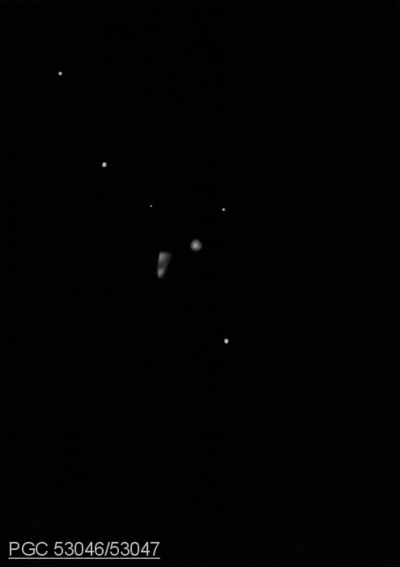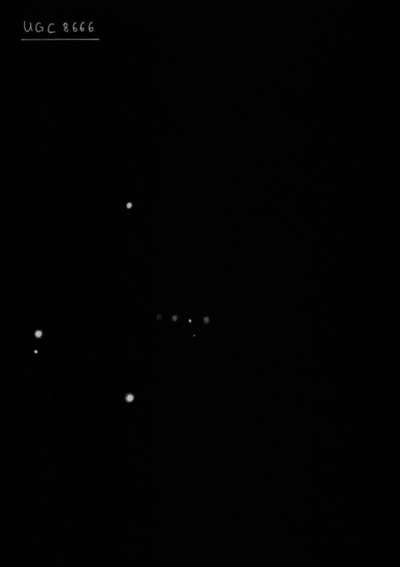The large equatorial constellation of the zodiac, in which the intersection of the ecliptic and the equator lies, and through which the Sun passes from 16 September to 30 October, the time of the autumnal equinox, the moment when summer ends and autumn begins. On the ecliptic it is located between Leo and Libra. Virgo is easily found by the elongated conjunction of the upper right and lower left wheels of the Big Dipper, although only four of its stars are brighter than 3rd magnitude. The constellation is Y-shaped in the sky, with Spica at its lower edge, the star γ Virginis at the bottom of a sort of bowl formed by the stars Porrima, Vindemiatrix, β, δ, η Virginis, and Denebola of Leo. The constellation is best seen in the evening sky from March to August. It peaks at midnight in the first decade of April about 40 degrees above the southern horizon. It contains 95 stars of apparent brightness up to 6mag. It is the largest constellation of the zodiacal constellation and the second largest after Hydra, occupying 0.393 sr in the sky.
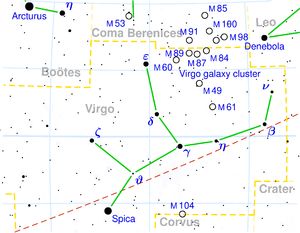
The constellation is interesting not only from a historical point of view, but especially from an astronomical one. Because Virgo lies very far from the dense clouds of the Milky Way, we find mainly distant galaxies, or more precisely, a large number of distant galaxies. The explanation is simple, looking between the stars Vindemiatrix and Denebola, at the boundary between the constellation Virgo and the Hair of Berenice, lies the heart of the huge Coma-Virgo supercluster of galaxies, to which the Local Group of Milky Way galaxies belongs. Rich outcrops and belts of galaxies extend across the sky to Centaurus and southeast to the tail of Hydra, as well as northwest to the Hounds and the Ursa Major. The exact location of the centre of this supercluster, is at a distance of about 54 million light years towards the two giant elliptical galaxies M84 and M86. The core is very dense, and in its central part, about 5 million light-years across (12˚ x 10˚ in the sky), we can count about 3,000 galaxies. And these are actually only the largest and brightest members - huge elliptical galaxies and spiral galaxies similar to our own Milky Way or the Andromeda galaxy, because dwarf elliptical and various irregular galaxies may not show up in photos from even the largest telescopes.
So Virgo brings a wide variety of galaxies, distant and less bright objects to our observing program, for which we will need preferably a 250mm or larger telescope. However, some of the galaxies are quite bright, after all, eleven of them are stuck in Charles Messier's famous catalogue. Like this supercluster, or just a small group of galaxies like our Local Group, they are actually the rule rather than the exception in deep dark space. The Coma-Virgo cluster itself is probably the center of a larger cluster of galaxy clusters that surpass all our imaginations. If we look to the other side of the sky from the constellations Virgo and Berenice's Hair, for example towards Whale, Eridanus or Pecus, we can see other, much more distant superclusters of galaxies in a large telescope, or rather, only their brightest members. Clusters of galaxies in Hercules or the Northern Crown are also known.
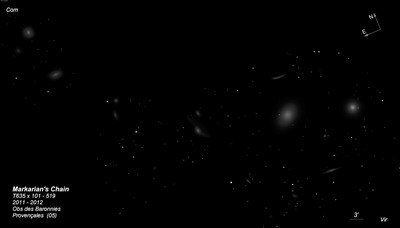
Spika (α Virginis) - The brightest star of the constellation, reaching a magnitude of 1. This purely white, bright star can be used for orientation in the spring sky, as it forms the so-called spring triangle along with the stars Regulus in Leo and Arcturus in Bootes, a kind of counterpart to the better-known summer triangle. It is located on the extended line connecting the upper right and lower left wheels of the Big Dipper. It is about 250 light-years away and exceeds the brightness of the Sun by a factor of 2,800. It is a very close spectroscopic binary star (an eclipsing variable star) with a period of 4.014 days. During this period, there is a regular slight partial eclipse, about one-tenth of the brightness, which is not visually perceptible. The main star of this pair also exhibits weak pulsation with a period of 0.174 days. Spica has a surface temperature of nearly 20,000 ˚C and shines with the power of more than a thousand Suns.
Porrima (γ Virginis) - One of the most beautiful double stars in the sky, both yellow-white components have almost the same brightness of 3.5 magnitude and can be observed with a 6 cm telescope at a separation of 3". Their orbital period around the common center of mass is 171.85 years. The largest separation was reached in 1920 - 6.2", so they could be distinguished even with a 5 cm telescope. Meanwhile, their mutual distance is rapidly decreasing. In 1985, the value reached 3.5", in 2000 only 1.8". Therefore, currently we need at least a 200 mm telescope to distinguish the two point-like stars under good seeing conditions. In 2007, the separation will be even smaller, only 0.3", and therefore we will need a significantly larger telescope to resolve them. The system is located 32 light-years away from us. Five arc degrees to the north lies the brightest quasar - thirteenth magnitude, labeled 3 C 273, located approximately 3 billion light-years away.
θ Virginis - A remarkable triple star system, located at a distance of 200 light years. The two brighter components are separated by 7.2" and have magnitudes of 4.4 and 9.4. To resolve them, a telescope with an objective diameter of 6 to 8 cm is needed. In a good 100 instrument, a third companion of magnitude 10.4 will also be visible, at a separation of 69.6" from the main white star (the second component appears faintly yellow).
φ Virginis - The triple star system consists of two stars (yellow and orange) with magnitudes of 4.8 and 9.3, separated by 4.8", and a third blue component with a magnitude of 12.4 at a separation of 93".
84 Virginis - Double star consisting of a close pair of conspicuously orange (5.5 mag) and dimly yellow components (7.9 mag) with a separation of 2.9". A telescope with an objective diameter of around 100 mm is recommended for resolution.
54 Virginis - An attractive pair of yellow (6.8 mag) and white stars (7.3 mag) at a separation of 5.4" is visible even in small telescopes at 100x magnification.
R Virginis - The variable star of Mira Ceti type, with a magnitude change from 6.0 to 12.1 over 146 days. It is assumed to be a red star of class M.
Struve 1788 - quadruple star, close pair of two beautiful yellow stars (6.5mag and 7.7mag) with a separation of 3.4 ", accompanied by two additional, much fainter components with magnitudes of 10.3 and 10.9mag. Recommendation: 100-150 mm and at least 100x magnification.
M 104
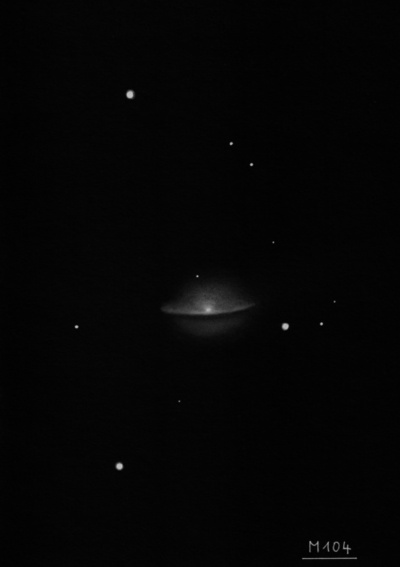
15x50mm (6/19/08 and 4/6/13): easily visible in binoculars as a elongated glow with brighter center.
Pierre Méchain discovered M104 = NGC 4594 = H I-43 = h1376 on 11 May 1781, after Messier's final catalogue was sent to publication. The discovered was mentioned in a letter dated 6 May 1783 to Johann Bernoulli, the editor of the Berliner Astronomisches Jahrbuch. He wrote, "On May 11, 1781, I have discovered a nebula above Corvus; it did not appear to me to contain stars; it is faint & very difficult to see when the wires of the micrometer are illuminated; I have compared it on this day & the following to the Ear of Virgo [Spica], & I have derived its right ascension 187d 9' 42", its south. declin. 10d 24' 49". It is not included in the Connoissance des tems." The note was published near the end of the 1786 Jarbuch volume. Messier penciled in the position into his own copy of his catalogue, published in 1784. French astronomer Camille Flammarion introduced the new designation M104 in 1921.
As M104 wasn't published in Messier's catalogue, William Herschel was unaware of it and rediscovered it on 9 May 1784 (sweep 210). He wrote, "E, vBM, about 5 or 6' long, but daylight is too strong to see the whole extent of it. The bright place in the middle is prety large, but breaks off abruptly." He made a second observation on 11 Mar 1788 (sweep 819): "mE, from about 20° sp. to nf., BN, 4 or 5' long."
John Herschel was the first to note the dust lane. On 9 Mar 1828, he recorded "vB, vmE, in pos 2° np to sf; vsmbM to a nucleus; 5' l, 30" br, a bright star sp. There is a faint diffused oval light all about it, and I am almost positive that there is a dark interval or stratum separating the nucleus and the general mass of the nebula from the light above (south) of it. Surely no illusion." In his sketch (Fig. 50) he adds the remarks "The strong suspicion of a parallel appendage to the latter of these, is almost converted into certainty by its undoubted existence in V. 24 [NGC 4565], in which it was seen by two other observers as well as by myself." Later sketches were made by William Lassell in 1862 with his 48" and Wilhelm Tempel in 1882 with an 11" refractor. The first photo was taken by Isaac Roberts in April 1897.
Leland Copeland called M104 the "Sombrero" in the June 1942 issue of S&T. The back cover featured an image taken by the Mount Wilson 60-inch in 1916. The image is referred to as the "Sombrero nebula". The classic photo of M104 was made with the Palomar 200-inch in 1950 and published in the Hubble Atlas of Galaxies.
300/350mm - 13.1" (4/24/82): very bright, large, very elongated, arms long and thin. A prominent dark lane is visible along the length of the galaxy. Only a faint glow is visible to the south of the dust lane.
400/500mm - 17.5" (3/12/94): very bright, very large, elongated 3:1 E-W, 7.5'x2.5'. Very prominent dust lane along the entire length of the major axis and divides the core into two non-symmetric sections. The prominent section of the core is just north of the dark lane. Overall, the galaxy is brighter and much more extensive to the north of the lane. The portion of the core and halo south of the dust lane is much fainter, smaller and unconcentrated. A mag 10 star lies 4' WSW.
900/1200mm - 48" (2/20/12, 4/5/13, 4/30/19): stunning view of the jet-black super high-contrast dust lane at 375x. The fainter section of the galaxy south of the dust lane was quite prominent and nearly as extensive as the northern half and the central bulge region was noticeably thicker in proportion to the major axis than views in smaller scopes. I also clearly noticed that although the dust lane was very flat in the central region (oriented precisely E-W), it bent slightly north and widened just a bit on both the east and west ends of the disc, giving it a slightly warped appearance.
Notes by Steve Gottlieb
M 61
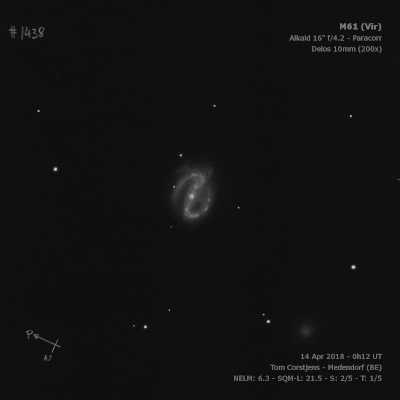
Italian astronomer Barnaba Oriani discovered M61 = NGC 4303 = H I-139 = h1202 on 5 May 1779 while observing the Comet of 1779. It was independently found by Messier the same night, though initially he mistook it for the comet, finally recognizing it was a nebula on 11 May. William Herschel found M61 on 17 Apr 1786 (sweep 553), assumed it was new, and catalogued it as I-139 with the summary description (2 observations) "eB; vBN; r, 6 or 7' dia." John Herschel observed in on 3 consecutive sweeps in 1828, describing it on 10 April as "very faintly bicentral. The two nuclei 90" distance in position angle 45 to 50° north-following." This comment was the source of the GC and NGC description "bi-nuclear" and the second nucleus is very likely the bright knot on the northern spiral arm.
Bindon Stoney discovered spiral structure on 1 Mar 1851 and noted "spiral, 2 knots, centre bright. There is another neb. 10' nf." A sketch made of M61 on 14 Apr 1852 was included in the 1861 publication, though misidentified as h1196 [NGC 4292]. The two knots clearly included in the sketch are [HK83] #91 and [HK83] #155, mentioned in my 24-inch observation. The neb 10' nf probably refers to NGC 4301 = NGC 4303A = UGC 7439. See that number.
Host of 8 supernovae since 1926 (six of these since 1961), making M61 the current record holder among Messier galaxies. The first (SN 1926A) was found by Max Wolf and Karl Reinmuth at the Heidelberg Observatory.
300/350mm - 13.1" (5/26/84): very bright, large, bright stellar nucleus. Two spiral arms are faintly visible; one arm is attached south of the nucleus and winds towards the west and then north. A slightly brighter arm is attached north of the nucleus and winds along the east side towards the south. In the field with NGC 4292 11' NW and NGC 4301 10' NE.
400/500mm - 18" (5/12/07): spiral structure was easily visible. One arm is attached at the north end and sweeps towards the northeast and then hooks to the south along the east side. A bright knot ([HK83] #91) is within the arm at the northeast end. A second broader arm is attached at the south end and sweeps towards the southwest and then hooks towards the north on the west side. The central region contains a bright, stellar nucleus.
600/800mm - 24" (5/20/20 and 5/24/20): viewed SN 2020jfo (Type II), discovered on May 6th 1.1' W and 0.5' N of the center of the galaxy. This is the 8th SN discovered in M61 since 1926, the most of any Messier. It appeared very close in brightness to a mag 14.2 star that is 1.2' W of center and collinear with another mag 14 star 2.4' SW of center.
M61 appeared strongly concentrated with a bright elongated core or bar oriented N-S that increased to an intense, very small nucleus. Three arms were easily visible. A short but well defined arm angled SW-NE on the north side (outside the eastern arm). It ended at a relatively bright HII knot [HK83] #91, which was well defined and noticed immediately. The eastern arm, which emerged from the north side of the bar, was very well defined and extended east of the core, then headed south and angled towards the southwest. The western arm began on the south or southeast side of the bar and rotated counterclockwise towards to the west and bent in the northwest direction. It past inside a 14th mag star [1.1' W of center]. A subtle brightening or knot, [HK83] #155, was seen along this arm 40" S of center (collinear with the northern knot and the center).
900/1200mm - 48" (4/5/13) and 5/1/19) at 375x and 488x, the visible structure was similar to photographic detail! A bright bar extends north-south and is sharply concentrated with a very small, round, intense nucleus. A bright arm is attached right at the north side of the bar and sweeps counterclockwise 180° to the south end, along the east side. A brighter region was visible in the arm east of the nucleus, which include HII regions NGC 4303:[HK83] #35/39/41/45/49, from the Hodge-Kennicutt "Atlas of H II regions in 125 galaxies". At this location, the arm has a sharp turn [63°] and angles towards the SW. The arm dims rapidly on the south end, but I was able to follow it much further SW in the outer halo, where it passes just north of a mag 14.0 star [2.4' SW of center].
The western arm is attached at the southern end of the bar and sweeps north on the west side. A bright, elongated patch is on the southern end of this arm, which includes [HK83] #155, ~45" SSW of the nucleus. The arm extends inside a mag 14 star in the west side of the halo [1.2' WSW of center] and then sharply dims but extends towards #242, a nearly detached faint knot 1.2' WNW of center.
A partial outer arm, not attached to the core, was easily visible on the north side, angling southwest to northeast. At the NE end of this short bright arm is the HII knot [HK83] #91, a very bright, 15" knot, 1.2' NNE of center. The arm dims suddenly on the northeast end but a diffuse extension continues to wrap counterclockwise to the southeast at the edge of the eastern halo.
Notes by Steve Gottlieb
M 49
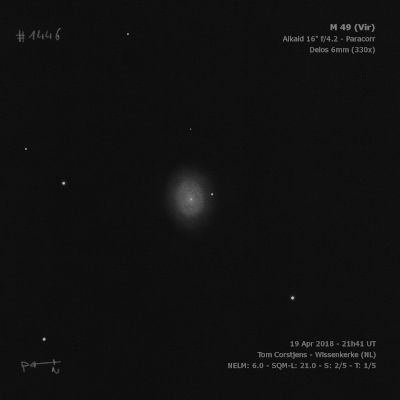
Charles Messier discovered M49 = NGC 4472 = H I-7 = h1294 on 19 Feb 1771 (first Virgo cluster member discovered). Oriani Independently found it on 22 Apr 1779 while following a comet that passed through the Virgo cluster. Admiral Smyth confused these discovery dates, causing later confusion on the primary discoverer.
William Herschel first recorded M49 on 23 Jan 1784 (early sweep 105) and described I-7 as "A beautiful nebula. Not cometic. It is visible in the finder and vB in the telescope", but his RA was 11 min too large. On 28 Dec 1785 (sweep 498) he called M49 "vB, cL, gmbM, extended with F branches." John Herschel made 5 observations, recording on sweep 253, "eB; L; R psmbM; insensibly fading away, has a * 13m following; by diag the star is just beyond the nebula." Heinrich d'Arrest claimed he resolved the cluster and saw "countless groups of stars; at 147x, the nebula periphery can be resolved into stars of the 13th and 14th magnitudes."
400/500mm - 17.5" (4/18/87): very bright, fairly large, sharp concentration to a compact very bright nucleus, large halo slightly elongated ~N-S fades at the edges. A mag 12 star is superimposed at the east edge 0.8' from center. A faint galaxy NGC 4467 lies 5' W.
900/1200mm - 48" (5/15/12): at 488x, M49 appeared extremely bright and large, slightly elongated N-S, ~6'x5', fades gradually so the outer extent may be larger. Well concentrated with an intense core that is sharply concentrated with a brilliant nucleus. A mag 12 star is superimposed 45" E of center. A number of galaxies (see below) surround the halo, including NGC 4467 4' W and NGC 4465 5.9' WNW. A mag 13 star is 4.6' W of center (close to NGC 4467).
VCC 1199, 4.5' NW of center, appeared faint, very small, round, 10" diameter.
VCC 1203, 4.6' SSW of center, is fairly faint, fairly small, round, 12" diameter, slightly brighter core. VCC 1203 is misidentified as NGC 4471 in SIMBAD. The NGC number probably applies to one of the two faint stars ~2' SE.
UGC 7636, 5.4' SE of center, is very faint, fairly small, elongated patch, ~0.5'x0.3' N-S, with a very low surface brightness and no concentration. This blue, dwarf irregular companion (Arp called it a "fragment") has been disrupted by M49 with H I gas stripped in a tidal tail.
Notes by Steve Gottlieb
M 87
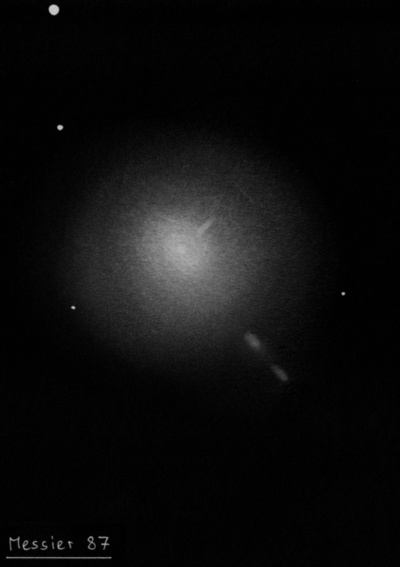
Charles Messier is credited with the discovery of M87 = NGC 4486 = h1301 on 18 Mar 1781. But Wolfgang Steinicke recently found (email Oct '16) that Johann Gottfried Koehler made the original discovery on 5 May 1779. On 17 Apr 1784 (sweep 199), WH logged "Three nebulae, the two first [NGC 4476 and 4478] vF, S, the third [M87], B, L, mbM but diminishing very gradually in brightness." JH made at least 5 observations, recording on sweep 245, "vB; vL; R; psmbM; r; 3' diam."
M87 is one of the most distant galaxies (~52 million light years) visible in binoculars. It contains a 6.4-billion-solar-mass black hole (1,000 times more massive than Sgr A). The 20" jet was discovered by Heber Curtis at Lick Observatory in 1918 and described as a "curious straight ray lies in a gap in the nebulosity in pa 20°, apparently connected with the nucleus by a thin line of matter. The ray is brightest at the inner end, which is 11" from the nucleus."
A supernova (1919A) was found in 1922 by Russian astronomer Balnowski on a plate taken 24 Feb 1919.
300/350mm - 13.1" (5/14/83): very bright, intense core, fairly smooth halo.
400/500mm - 17.5" (5/23/87): very bright, fairly large, gradually increases to a very bright core, no sharp nucleus. A very compact galaxy NGC 4486A = UGC 7658 lies 7' S.
600/800mm - 24" (5/29/14): extremely bright, large, slightly elongated NNW-SSE, ~4'x3.5', well concentrated with a large, intense core. The core brightens but there was no distinct nucleus. The halo gradually fades and increases in size with averted vision. Several galaxies are nearby including NGC 4486B 7.2' NW, NGC 4486A 7.6' SSE, NGC 4478 8.7' SW and NGC 4476 12.6' WSW.
900/1200mm - 48" (5/4/16 and 4/30/19): at 488x, 610x and 697x; M87's jet was almost continuously visible as a small, very thin spike extending to the west-northwest of the core, perhaps 15"x2". When the seeing was sharp, there was a brighter, knot (stellar) at the outer tip that sometimes appeared detached. There was a strong impression of a second stellar knot within the spike.
48" (4/1/11): at 488x, the jet in M87 was immediately noticed as a short, faint spike poking out of the central core to the WNW and the position angle [290-300°] was accurately sketched without prior knowledge. The narrow jet brightened or there was a knot at the outer tip.
In addition to looking for the jet, I sketched three companions at the edge of the outer halo on the southwest side. About 2' SW of the center of M87 is a pair of very faint, roundish galaxies, both ~15" diameter. The pair forms UGC 7652 with the components separated by 40" and nearly aligned with the center of the galaxy as if they were ejected. 2MASX J12303903+1222222, an extremely faint companion (V = 17.9), lies 2.8' WSW of the core, just 20" SE of a mag 15.5 star. The three close "companions" to M87 are actually part of a distant, poor cluster in the background of M87, with a redshift of 20x that of M87!
Virgo UCD 3 is either one of the brightest globular clusters in M87 or a nucleated dwarf galaxy, called a Ultra-Compact Dwarf (UCD). It is situated just 3.0' NE of the center of M87, directly opposite the two small galaxies at the southwest edge of the halo of M87. A mag 14.5 star, just 20" SSW, is a perfect reference to focus on the cluster. On 4/16/13 using 488x it was suspected as an 18th magnitude "star", but I didn't feel confident of the observation. At 813x, though, it was confirmed as an extremely faint, stellar object, glimpsed several times at the same position.
Notes by Steve Gottlieb
M 60
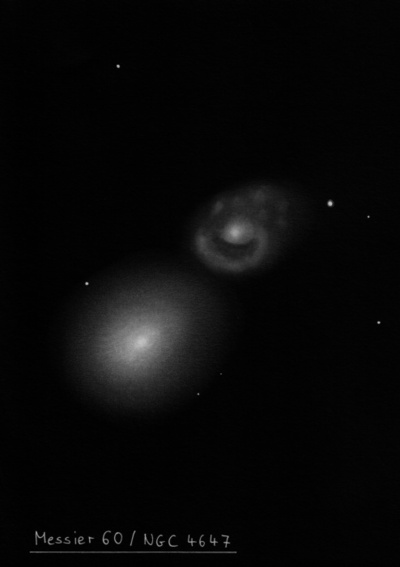
Johann Koehler discovered M60 and M59 on 11 Apr 1779 and noted "Two very small nebulae, hardly visible in a 3-foot telescope: The one above the other." Koehler was tracking the comet of that year. Oriani independently discovered M60 on 12 Apr 1779, noting "Very pale and looking exactly like the comet." Also, Messier made an independent discovery on 15 Apr 1779 (along with M58 and M59).
William Herschel first recorded M60 on 15 Mar 1784 (sweep 174) as "Two nebula [with NGC 4647], one of them vB." John Herschel's first observation was on 11 Apr 1825 (sweep 3). He logged, "A most curious double nebula. The center dist 1/6 of the field or about 3'. They join with very faint nebulosity."
300/350mm - 13.1" (5/14/83): bright, very bright nucleus, slightly elongated ~E-W.
400/500mm - 17.5" (4/25/87): very bright, fairly large, diffuse halo, slightly elongated ~E-W, very bright core with a bright substellar nucleus. Forms a double system with NGC 4647 which is almost tangent to M60 barely off the NW edge.
900/1200mm - 48" (4/19/17): at 697x; M60 and NGC 4647 were viewed but my main target was UCD 1, the brightest ultra-compact dwarf in M60. It appeared as a very faint, possibly "soft" star, just visible continuously with averted vision, and situated 1.4' SW of the center of M60. The UCD forms a wide pair with a slightly brighter mag 16.5 star 0.5' NW. CGCG 071-018 lies 6' SE of M60 and was logged as fairly faint (V = 15.5), moderately large, very elongated 3:1 E-W, 0.6'x0.2', fairly even low surface brightness.
Notes by Steve Gottlieb
M 86
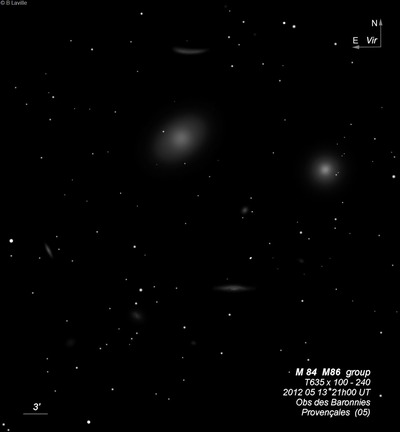
Charles Messier is credited with the discovery of M86 = NGC 4406 = h1253 on 18 Mar 1781, along with M84, and described a "Nebula without star, in Virgo, on the parallel and very near to the nebula above, No. 84: their appearances are the same, & both appear together in the same field of the telescope." But Wolfgang Steinicke recently found (email Oct '16) that Johann Gottfried Koehler made the original discovery on 5 May 1779. WH only recorded it on 17 Apr 1784 (sweep 199) and simply noted "B. Is No. 74 of the Connoissance des Temps." JH listed M86 as a "Nova", probably due to the poor positions of his father. On sweep 22 he logged "vB; R; gbM to nearly a star" and on sweep 243 "vB; L; pgmbM; r."
300/350mm - 13.1" (5/14/83): very bright, larger and more elongated than M84.
400/500mm - 17.5" (4/25/87): very bright, fairly large, slightly elongated 4:3 NW-SE, 4'x3', intense core, substellar nucleus, large diffuse halo. One of the two brightest galaxies in the core of the Virgo cluster along with M84 17' W. NGC 4402 lies 10' N.
600/800mm - 24" (4/28/14): at 260x appeared extremely bright, very large, oval 3:2 NW-SE, 4.5'x3.0'. Sharply concentrated with a very intensely bright core that increases down to the center. The halo increases in size with averted and gradually fades out at the periphery. Brightest galaxy in the central core of the Virgo cluster.
Notes by Steve Gottlieb
M 84
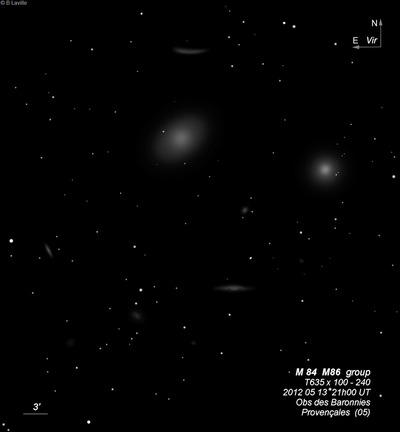
Charles Messier is credited with the discovery of M84 = NGC 4374 = h1237 on 18 Mar 1781, along with M86, and described a "Nebula without star, in Virgo; the center it is a bit brilliant, surrounded with a slight nebulosity: its brightness and its appearance resemble that of those in this Catalog, No.s 59 & 60." But Wolfgang Steinicke recently found (email Oct '16) that Johann Gottfried Koehler made the original discovery on 5 May 1779 using a Dolland refractor of 6-ft focal length. WH only recorded it on sweep 199 from 17 Apr 1784 and simply noted "B. Is No. 84 of the Connoissance des Temps." JH also recorded it only a single sweep, noting "vB; R; psbM; 60"; r."
300/350mm - 13.1" (5/14/83): very bright, very bright core. Located in the core of the Virgo cluster.
400/500mm - 17.5" (4/25/87): very bright, moderately large, almost round, very bright core, very small bright nucleus, halo gradually fades into background sky so there is no sharp edge. Nearly an identical twin of M86 17' ENE but rounder.
600/800mm - 24" (4/28/14): extremely bright, large, slightly elongated, ~4'x3.5', sharply concentrated with a very intense core that increases gradually to a nonstellar nucleus. The large halo gradually fades out. A mag 14.5 star is superimposed on the SW side of the halo, 1.2' from center. In the 23' field (at 260x) is M86 17' ENE, NGC 4438 17' SE, NGC 4387 10' ESE, IC 3303 11' SSE
Notes by Steve Gottlieb
M 90
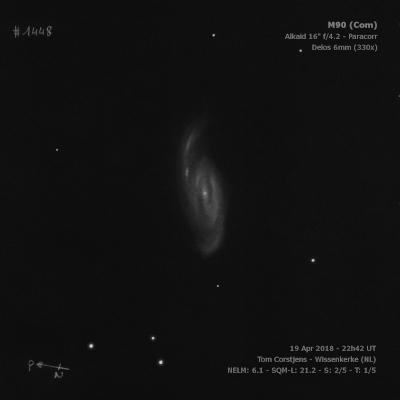
Charles Messier discovered M90 = NGC 4569 on 18 Mar 1781. WH observed M90 on 8 Apr 1784 (sweep 187) and logged "pL, with a nucleus, perhaps cometic, but moonlight permits not to give a proper description." JH did not make an observation.
400/500mm - 17.5" (4/25/87): bright, large, very elongated 3:1 SSW-NNE, sharply concentrated, suddenly increases to a bright stellar nucleus (possibly a superimposed star), fairly even surface brightness to halo. IC 3583 lies 6' NNW.
Notes by Steve Gottlieb
M 89
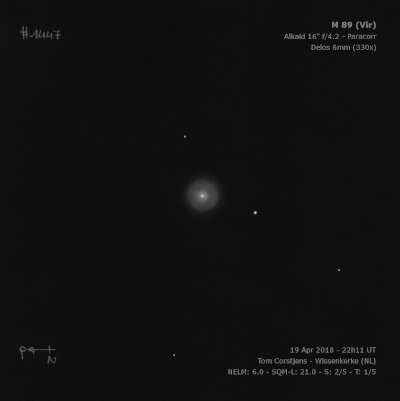
Charles Messier discovered M89 = NGC 4552 = h1348 on 18 Mar 1781. William Herschel made an observation on 17 Apr 1784 (sweep 199) and noted "B, pS." John Herschel made four observations and recorded on 10 Apr 1825 (sweep 2) "F; R; gbM; 25"; has a * nf." On 4 May 1829 (sweep 192) he called M89 "B; R; gbM; 40...50" [diameter]."
400/500mm - 17.5" (4/25/87): very bright, irregularly round, fairly small but high surface brightness with an intense, very small bright core and substellar nucleus. Forms a pair with NGC 4550/NGC 4551 pair 20' S.
Notes by Steve Gottlieb
NGC 4216
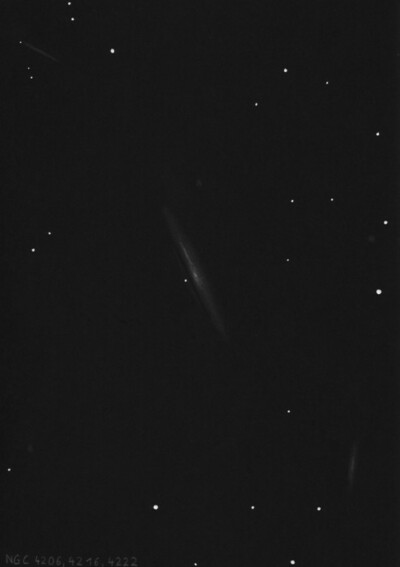
William Herschel discovered NGC 4216 = H I-35 = h1148 on 17 Apr 1784 (sweep 199) and recorded "vmE, vbM and the brightness also elongated. The whole not less than 9 or 10' long." John Herschel made 5 observations, the earliest 10 and 11 Apr 1825 (sweeps 2 and 3). On sweep 3 he logged, "A very remarkable long ray, extended 70° nf to sp, 1/2 field in length [7 1/2'], smbM. It has a star nf of center."
Samuel Hunter, LdR's assistant on 23 Apr 1860, recorded "a fine E neb, vBM like a globular cluster (I think too it is resolvable?), small star following nucl, where I also think there is very dilute nebulosity, parallel to neb [beyond the dust lane]. The neb is either twisted at n end in p direction or it has a faint companion there? Dark space around centre? perhaps only the contrast of the bright centre. 15' long." The possible nebula Hunter mentions to the north is likely CGCG 069-113.
400/500mm - 17.5" (1/23/88): very bright, very large, edge-on 5:1 SSW-NNE, small very bright core. A mag 14 star is close east of the core. This is a striking galaxy and is the second of three edge-on galaxies in the same field with NGC 4206 11' SW and NGC 4222 12' NE in Coma Berenices!
Notes by Steve Gottlieb
NGC 4517
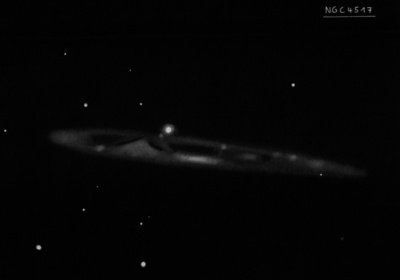
NGC 4517A, located 17' NNW, appeared very faint, large, small brighter core. Appears as a very diffuse hazy region elongated SSW-NNE with no distinct boundaries. Located 3.5' SE of a mag 10.5 star.
William Herschel discovered NGC 4517 = H IV-5 on 22 Feb 1784 (sweep 153) and recorded "A pretty bright star with a milky ray on the south side of it, extending from east to west, or rather from np to sf. It does not seem to touch the star, and is about 10 or 12' in length." On a second observation (1 Jan 1786, sweep 507), he added "a pB star with a milky ray to the south of it, and partly including it." WH commented this might suggest that the nebula had a considerable proper motion, though differences in observing conditions might account for the difference. The GC and NGC position (from 3 observations) is 0.5 min of RA too far east and 2' south.
JH found h1277 = NGC 4437 on 14 Apr 1828 and recorded "F; vmE; pos 15° nf to sp; a long ray; it is south preceding a * 10m. The place is that of the star." There is nothing near his position, but 5 min of RA east is NGC 4517 and his description is a perfect match with this galaxy. The equivalence may have first been suggest by Karl Reinmuth in his 1926 photographic Heidelberg survey "Die Herschel Nebel". Various sources (including the RNGC) mistakenly equate NGC 4437 with NGC 4417, instead of NGC 4517. So, NGC 4517 = NGC 4437.
400/500mm - 17.5" (3/24/90): moderately bright, very large edge-on 8:1 WSW-ENE, almost 10'x1.2'. This galaxy is an impressive large narrow streak with fairly low surface brightness and fills 1/2 of the 21' field. There is no well-define nucleus but central region slightly bulges. Appears brighter along the western extension. A mag 9 star is attached at the northeast edge of the core.
900/1200mm - 48" (5/4/16): beautiful edge-on spiral, nearly 8:1 WSW-ENE, ~11'x1.5'. A mag 10.9 star is attached on the north edge, just east of center. The galaxy is broadly concentrated with a larger, brighter core region and small brighter nucleus. A fairly prominent, irregular dust lane extends ~5', unevenly slicing the galaxy along the north edge of the core region. The absorption lane is widest and most prominent near the core. A fairly thin strip of the galaxy is visible to the north of the dust lane, passing through the bright star at the north edge. The dust gives the galaxy an irregular patchy appearance and along with some mottling, the view is reminiscent of NGC 253 or NGC 55.
NGC 4517A, situated 17' NNW, appeared moderately bright, large, oval 4:3 SSW-NNE, ~3'x2.2', broad concentration with a small brighter core, patchy, irregular surface brightness. A mag 10 star is 3.5' NW and a mag 11.5 star is 4.6' W.
Notes by Steve Gottlieb
M 59
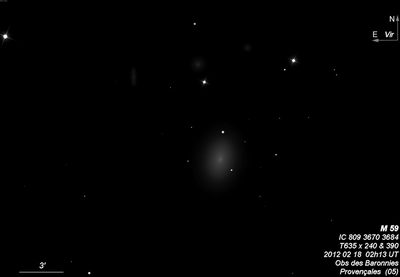
Johann Koehler discovered M59 = NGC 4621 = h1386, along with M60, on 11 Apr 1779. It was independently found by Charles Messier 4 nights later. On 17 Apr 1784 (sweep 199), William Herschel recorded "pB, R, not S, mbM." John Herschel made 3 observations and logged on 4 Apr 1831 (sweep 338), "vB; S; lE; vsvmbM; 2' l, 1 1/2' br."
300/350mm - 13.1" (5/14/83): bright, slightly elongated N-S, bright core. M60 lies 25' E and NGC 4606/4607 is 20' NW.
400/500mm - 17.5" (4/25/87): very bright, moderately large, oval NNW-SSE, 3'x2', small very bright core, stellar nucleus. A mag 15 star is at the SW edge and a brighter mag 13 star is off the north end 1.9' from center. The NGC 4606/NGC 4607 pair lies 20' NW.
600/800mm - 24" (5/22/17): at 200x and 375x; extremely bright, very large, oval 4:3 or 3:2 NNW-SSE. Strongly concentrated with a very bright roundish core and an intensely bright quasi-stellar nucleus. The core/nucleus is within a brighter central region, but then the surface brightness drops sharply with a very low surface brightness outer halo that extends 3.5'x2.5' NNW-SSE. A mag 12 star is at the north edge of the halo. IC 809 = IC 3672 lies 6.5' NNE, just north of an 11th magnitude star.
900/1200mm - 48" (4/19/17): at 697x; extremely bright, very large, oval nearly 3:2 NNW-SSE. Contains a very bright elongated core and an intensely luminous nucleus.
UCD 3, the brightest ultra-compact dwarf in M59 (considered the remnant nucleus of a recently accreted galaxy) was easily visible continuously as a mag 16.4 "star 2.2' E of the center of M59. It forms a pair with a slightly fainter mag 16.5-17 star 20" NW. This object was announced in 2015 as the densest known galaxy!
UCD 1, located just 1.4' SW of the center of M59, appeared as a very faint, possibly "soft" star, just visible continuously with averted vision. It forms a wide pair with a slightly brighter mag 16.5 star 0.5' NW.
IC 809 = IC 3672, 6.6' NNE of M59, appeared moderately to fairly bright, fairly large, slightly elongated 5:4 NW-SE, contains a large brighter core but no nucleus, and a low surface brightness outer halo ~50"x40". A mag 10.9 star is 1.2' SSW.
Notes by Steve Gottlieb
M 58
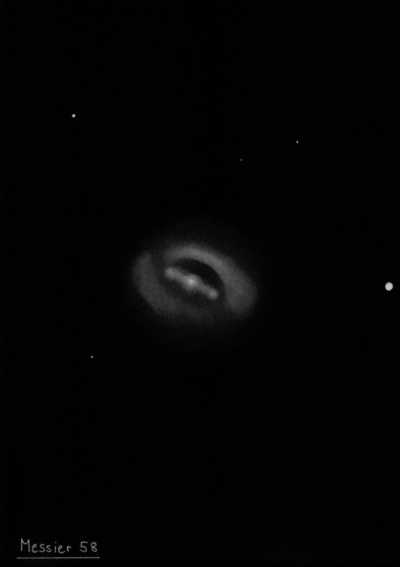
Charles Messier discovered M58 = NGC 4579 = h1368 (along with M59 and M60) on 15 Apr 1779. On 15 Mar 1784 (sweep 174), William Herschel logged, "pB, pL" on 15 Mar 1784. On 17 Apr 1784 (sweep 199) he wrote, "F, L.". JH made four observations, first on 9 May 1825 (sweep 4) as "vB; irreg R; gbM; a B * precedes 1/2 field.".
William Parsons apparently discovered spiral structure in M58 before 1850 as it was included in the listed of "Spiral or curvilinear" nebulae in the 1850 PT paper. The 1861 and 1880 monographs, though, do not list an observation earlier than 1851.
300/350mm - 13" bright, increase to a small bright core, slightly elongated E-W, diffuse halo.
400/500mm - 17.5" (4/25/87): bright, moderately large, slightly elongated 4:3 WSW-ENE, small very bright core, stellar nucleus. Located 7.6' E of mag 8.3 SAO 100179.
Notes by Steve Gottlieb
NGC 4536
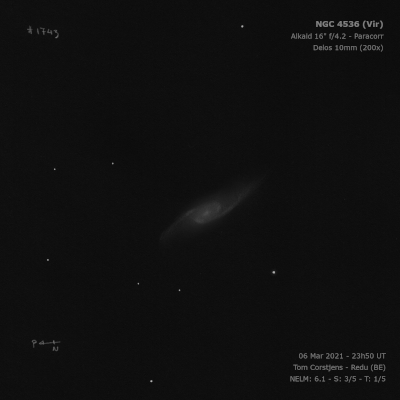
William Herschel discovered NGC 4536 = H V-2 = h1337 on 24 Jan 1784 (sweep 120) and noted "F, L, cE. It is bright in the middle in two or three places." He recorded the galaxy on 4 different sweeps. John Herschel reported "pB; vL; mE in pos 20° np; sbM."
R.J. Mitchell sketched the galaxy on 29 May 1856 with LdR's 72" and clearly showed the central bar and long arms forming an stretched "Z" shape. The sketch was included (Fig 24) in LdR's 1861 publication.
400/500mm - 17.5" (3/24/90): fairly bright, very large, very elongated NW-SE, weak concentration, stellar nucleus. Spiral structure is suspected at the ends of the major axis. Forms a pair with NGC 4533 8' N. Located 12' WSW of mag 7.0 SAO 119485 and 12' S of mag 8.6 SAO 119474 (4' N of NGC 4533). NGC 4527 lies 30' N.
600/800mm - 24" (5/24/20): at 260x; bright, very large, very elongated at least 3:1 NW-SE with two long slightly arched arms, ~6.5'x2', strong concentration with a bright elongated core that increased to a very small but non-stellar nucleus. The long eastern arm was attached on the north side of the core and was brightest in a 1.5'-2' section angling to the SE. The arm dimmed with a diffuse, lower surface brightness extension out to 3.5' SE of center, spreading further south at the eastern end. The western arm was also brightest in the initial 1' section on the west side of the core. The arm dimmed and thinned but stretched NW ~3' from center, where is seemed to bend north and fade out.
900/1200mm - 48" (4/4/13): very bright, gorgeous showpiece spiral with two very stretched arms extending northwest and southeast ~7'x2.5'. Contains a very bright, slightly elongated core that increases to an intense stellar nucleus. One long arm emanates from the west side of the core and shoots to the northwest, extending over 3' from the nucleus. Close west of the core is a brighter, knotty region identified as [HK 83] 66/67 in the Hodge-Kennicutt "Atlas of H II regions in 125 galaxies". The second arm is connected at the northeast side of the core and stretches to the southeast. A small brightening (#53) is just north of the core where the arm is attached. This arm contains a brighter, elongated section which includes [HK 83] 23/33/35/36, opposite the brighter region on the western arm.
Notes by Steve Gottlieb
NGC 4567
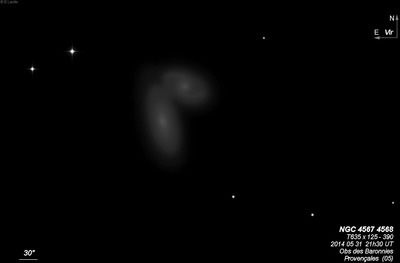
William Herschel discovered NGC 4567 = H IV-8 = h1358 = h1363 on 15 Mar 1784 (sweep 174) and recorded a "double nebula [with NGC 4568], or two p. considerable nebula apparently running into one another. The foregoing nebula [NGC 4564] may be taken into the field of view these two." Caroline's reduced position is ~6' southeast of the Siamese Twins.
Because of his father's poor position, John Herschel recorded the pair as a Nova (h1358 and 1359) at the correct position. He also made an observation with a poor position (h1363) that he associated with IV-8 and IV-9. The error was noted by d'Arrest in a 1863 paper.
The nickname "Siamese Twins" was coined by Leland S. Copeland and mentioned in his Feb. 1955 article "Adventuring in the Virgo Cloud".
200/250mm - 8" (4/16/83): faint, moderately large, appears as a double nebula at moderately large to high power.
300/350mm - 13" (4/16/83): fairly faint, elongated E-W. NGC 4568 is attached at the NE end.
400/500mm - 17.5" (4/25/87): northern member of a double system with NGC 4568. Moderately bright, fairly small, elongated 3:2 ~E-W. Slightly smaller than NGC 4568 attached at the east end but NGC 4567 has a slightly higher surface brightness.
Notes by Steve Gottlieb
NGC 5426
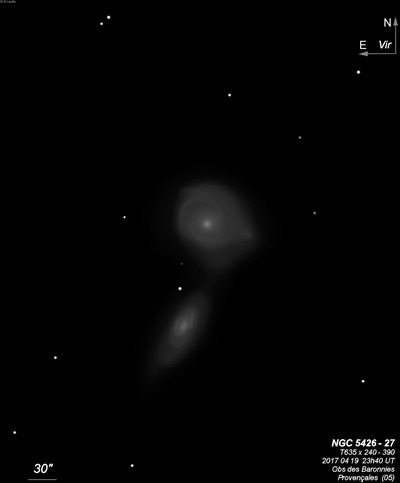
William Herschel discovered NGC 5426 = H II-309 = h1734, along with NGC 5427, on 5 Mar 1785 (sweep 380) and recorded "Two, pB, the northern one NGC 5427] cL and mbM. The southern one [NGC 5426] much less, and a little fainter, and a very small star or two between them, but not connected with them. Dist about 4' but the chevelures touch each other; nearly the same meridian [north-south]." His single position is at the northeast edge of NGC 5427. John Herschel made the single observation "the first of 2. Both L; F; vgbM; r; 3' dist' 70° np." See NGC 5428.
300/350mm - 13.1" (6/4/83): faint, small, slightly elongated N-S, small faint nucleus. Forms a close interesting pair with NGC 5427 2.3' N. A mag 13.5 star is 0.9' NNE of center directly between the two galaxies.
Notes by Steve Gottlieb
NGC 5746
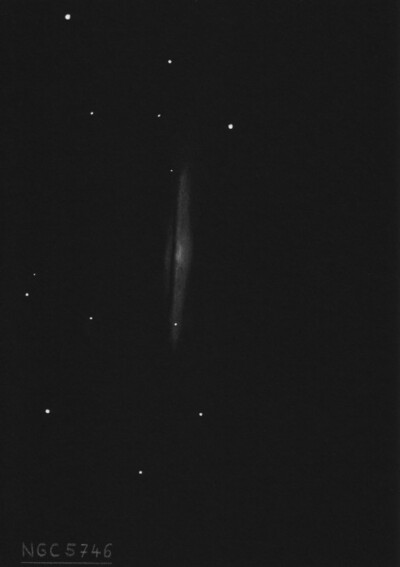
William Herschel discovered NGC 5746 = H I-126 = h1874 on 24 Feb 1786 (sweep 532) and recorded "eB, mE in the parallel [should be in the meridian], BN, 8 or 9' long." John Herschel made the single observation "a long pB ray with a pB nucleus; 3' long."
Lord Rosse made an early observation with the 72" on 25 Apr 1848. On 3 Apr 1875, Dreyer reported "there seems to be a split in the nebulosity following the nucleus." This clearly refers to the dust lane.
The RNGC declination is 10' too far south.
400/500mm - 17.5" (2/28/87): beautiful edge-on ~N-S, bright, fairly large, 4.5'x0.7', small bright core. A mag 15 star is at the south end 2' from the center. A dust lane is evident as a sharp light cut-off along the eastern edge. Located 5' SSE of mag 8.2 SAO 120633 and 20' WNW of 109 Virginis (V = 3.7).
900/1200mm - 48" (4/19/17): at 375x; gorgeous edge-on stretching nearly 7' NNW-SSE, It bulges nearly 1' in the core, though is much thinner towards the tips. Contains an intensely bright, elongated core with a rounder nucleus. The galaxy is sliced asymmetrically by a razor sharp, straight dust lane that splits the galaxy to the east of center, so that the main part of the galaxy is west of the dust lane. The portion of the disc on the east side of the lane is much fainter but shows up well as a thin strip, mostly visible in the central section east of the main section of the core. A bright mag 14 star is embedded on the south side, ~2' from the center. A mag 15.1 star is near the NNW end, off the east side and a mag 16 star is just west of the very NNE tip. Finally a mag 16+ star is superimposed just north of the core along the western flank ~0.6' from center. The galaxy is located 20' WNW of 109 Vir (V = 13.7) and mag 8.5 HD 129827 is 5' NW.
A small trio 17' to the west, consisting of LEDA 1210436 (V = 15.1), LEDA 1210907 (V = 17.1) and LEDA 1210022 (fits in a 2' circle) was picked up and observed at 697x. The light-travel time for all 3 is just over 1 billion years.
Notes by Steve Gottlieb
NGC 4388
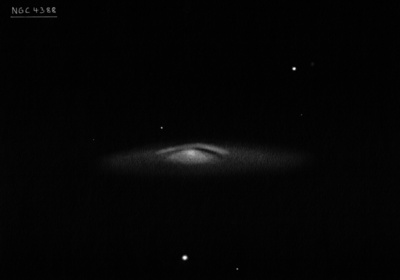
William Herschel discovered NGC 4388 = H II-168 = h1244, along with NGC 4387, 4413 and 4425, on 17 Apr 1784 (sweep 199) and recorded "Two nebulae [NGC 4388 and 4387]. The most southern [NGC 4388] extended." His position is between the two galaxies. John Herschel noted "vF; E; the p of 2 [with NGC 4413], dist about 30s in RA." He didn't realize this was the same as his father's II-168, so listed it as a "nova" and included separate listings in the GC for II-168 and h1244. Dreyer combined the listings in the NGC.
300/350mm - 13.1" (5/14/83): fairly bright, very elongated E-W.
400/500mm - 17.5" (4/25/87): moderately bright, edge-on streak E-W, fairly large, brighter core, thin extensions. A faint mag 14.5 star lies 1.3' NE of center. Located 16' SE of M84 in the core of the Virgo cluster. On a line between IC 3303 8.4' WNW and NGC 4413 11.4' ESE.
600/800mm - 24" (4/28/14): fairly bright, large, edge-on 4:1 E-W, well concentrated with a mottled, very bright core. Fairly sharp light cutoff on the south side (dust lane) of the core. Faint, stellar knots are at the west and east ends of the core.
Notes by Steve Gottlieb
NGC 5713
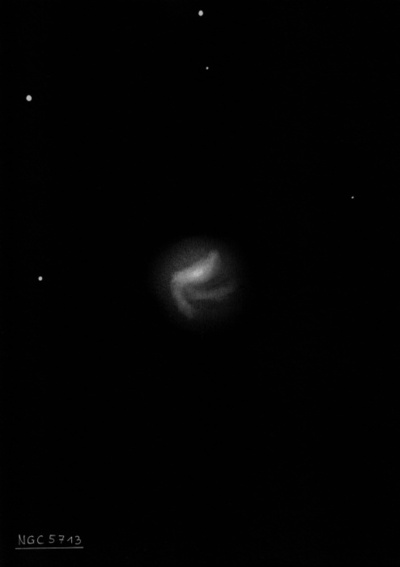
William Herschel discovered NGC 5713 = H I-182 = h1857 on 11 Apr 1787 (sweep 727) and noted "cB, pL, iR." JH made the single observation "B; R; psbM; r; 20"." d'Arrest measured this galaxy on 6 nights, so the NGC position is accurate. At Birr Castle, Bindon Stoney logged on 13 Apr 1852 "[NGC 5713] is gbM, a faint indication of spirality??" NGC 5651, discovered by George Bond at Harvard in 1853, is a duplicate observation. See that number.
400/500mm - 17.5" (4/13/91): fairly bright, moderately large, slightly elongated 4:3 E-W, broad concentration, asymmetric appearance. The brightest portion of the core seems offset to the west. The halo appears irregular and weaker on the south side. Forms a pair with NGC 5719 11' ESE. On the POSS, a single spiral arm winds from SW to NE but is absent on the south side.
Notes by Steve Gottlieb
NGC 5020
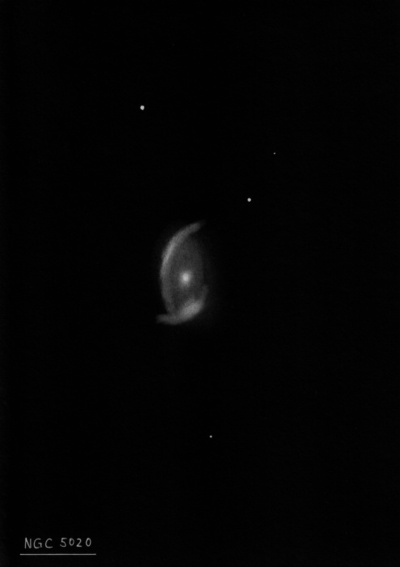
William Herschel discovered NGC 5020 = H II-129 = h1556 on 12 Apr 1784 (sweep 189) and recorded "F, pL, lbM, r, of a roundish figure." JH made three observations, first logging "F; pL; E; 30" long."
R.J. Mitchell, observing on 16 Feb 1855 at Birr Castle, recorded "S, R, pB Nucl, with (I suspect) straggling arms of F neby branching out, perhaps spiral."
400/500mm - 17.5" (5/19/01): this face-on barred spiral appears as a fairly large, round 2' glow of fairly low surface brightness. Contains a sharply defined, bright 20" core and a stellar nucleus. Located 15' SE of mag 8.4 SAO 100454.
Notes by Steve Gottlieb
NGC 5170
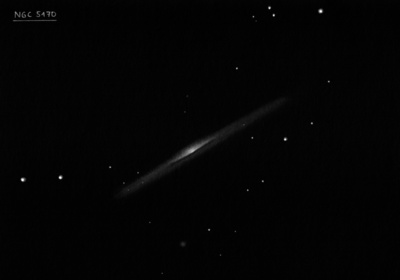
William Herschel discovered NGC 5170 = H V-22 = h1610 on 7 Feb 1785 (sweep 369) and recorded "mE from sf to np; 5 or 6' long, the following part is the brightest. His position matches this large edge-on. A second observation on 7 May 1787 (sweep 732) reads "pB, mE, the preceding part much brighter than the south following, about 4' long." JH made two observations, noting on sweep 354 "F; vmE in pos 128.8° by micrometer; pgbM; 180" l, 30" br."
400/500mm - 17.5" (5/19/01): fairly faint but large, very thin edge-on NW-SE. On first glance appeared 4'-5' in length at 220x but with averted vision this impressive ray extends to at least 6'x0.7'. Contains a moderately bright and slightly bulging oval core 1.2'x0.7' giving the galaxy a classic thin "lens" appearance. The extensions are significantly fainter and taper and dim towards the tips. This galaxy has a narrow dust lane (not seen) similar to NGC 4565. A mag 9.5 star lies 9' SW.
Notes by Steve Gottlieb
NGC 5496

Edward Holden discovered NGC 5496 on 23 Apr 1881 with the 15.6-inch Clark refractor at the Washburn Observatory and noted "E 180°, bM, 6'-8' long." His position (measured more accurately on 8 May 1882) matches UGC 9079. It's unusual that the Herschels missed this relatively bright galaxy.
Based on photographs taken at the Helwan observatory between 1919-20, it was described as "pB, 4.5' x 0.5', E 170°; rather irregular patch spiral seen almost edgewise, no nucleus"
200/250mm - 8" (6/30/84): extremely faint edge-on N-S, moderately large. Requires averted vision as the surface brightness is quite low.
400/500mm - 17.5" (4/5/97): fairly faint, large, very thin edge-on 6:1 NNW-SSE, ~3.5'x0.6'. Low surface brightness with only a weak concentration towards the center. A mag 15 star is embedded on the following side of the NNW extension [50" from center].
Notes by Steve Gottlieb
NGC 5468
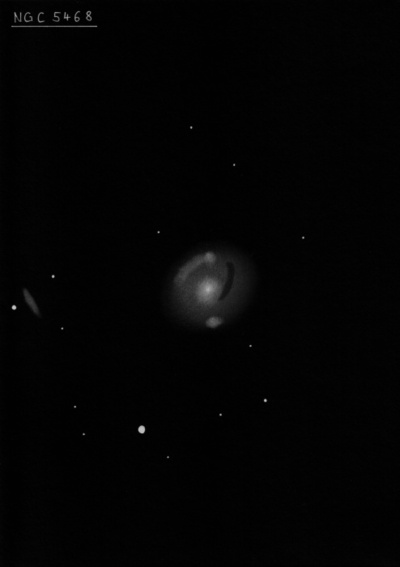
William Herschel discovered NGC 5468 = H III-286 = h1745 on 5 Mar 1785 (sweep 380) and recorded "vF, L, brightest towards the north, and eF towards the southern borders." John Herschel made the single observation "vF; vL; R; gbM" and measured an accurate position.
R.J. Mitchell, observing with LdR's 72" on 29 Mar 1856, recorded "1745 [NGC 5468] has a nucleus, light very patchy, 3 stars in edge; vF. Query, spiral with a right-handed twist. About 4' following is a S, pB, E knot." The object following is NGC 5472.
200/250mm - 8" (6/29/84): very faint, moderately large, very diffuse, elongated ~E-W. Located 4' NNW of a mag 8.3 star. A mag 10 star 11.9' SSE is collinear with NGC 5468 and the mag 8 star.
400/500mm - 17.5" (6/8/96): fairly faint, fairly large, round, 2.5' diameter. The low but irregular surface brightness halo has a hint of mottling or structure. Broad concentration to a ill-defined core and occasional small brighter nucleus. Mag 8.3 SAO 139737 4.2' SSE detracts from viewing. Forms a pair with NGC 5472 5.0' E.
900/1200mm - 48" (5/12/18): at 488x; NGC 5468 is a bright, fairly large 3-armed spiral! It appeared sharply concentrated with a very bright small nucleus and a 2'-2.5' halo containing two arms and a detached segment of an arm. One arm is nearly attached to the nucleus at its south side. This arm was easily visible as it rotated counterclockwise to the west and separated from the core, ending due west of center [by 0.6']. A low contrast arm begins just north of the nucleus and extends a short distance directly east. A faint 5" HII knot is just north of this arm. Finally a detached, arm segment, oriented WSW to ENE, floats in the south side of the halo. An easily visibile HII knot, ~8" diameter, is at its SW end. Forms a pair with NGC 5472 5' E. LEDA 1043616, a very low surface brightness galaxy, was picked up 6.4' SW. Mag 8.3 HD 123265 lies 4.3' SSE.
Notes by Steve Gottlieb
NGC 4197
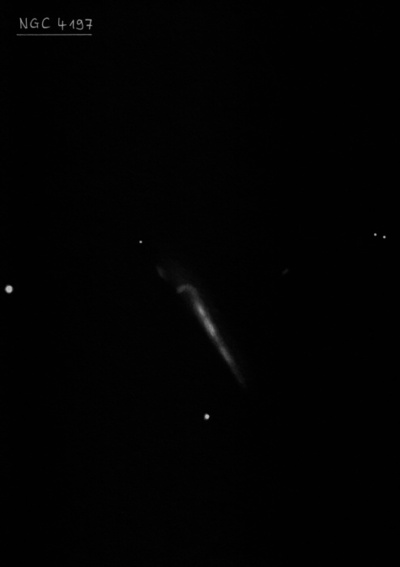
William Herschel discovered NGC 4197 = H II-134 = h1137 on 13 Apr 1784 (sweep 191) and noted "F, mE." JH recorded "pB; E; vgbM; 20"; like II. 133 [NGC 4180]." and measured an accurate position.
400/500mm - 17.5" (3/24/90): fairly faint, moderately large, edge-on 5:1 SW-NE, low even surface brightness. A mag 14 star is south of the SW end 1.5' from the center.
Notes by Steve Gottlieb
NGC 4356
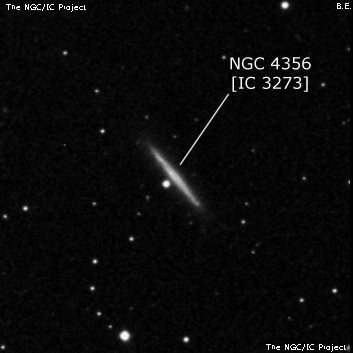
Arnold Schwassmann found IC 3273 = Sn. 95 on a plate taken 23 Jan 1900 with a 6" astrograph at Heidelberg. His position matches NGC 4356, although neither Schwassmann nor Dreyer caught the equivalence. UGC, CGCG and MCG label this galaxy as IC 3273 and ignore the NGC designation.
400/500mm - 17.5" (3/24/90): faint, edge-on SW-NE, low surface brightness. A mag 13 star is involved at the east edge of the core.
Notes by Steve Gottlieb
NGC 5634
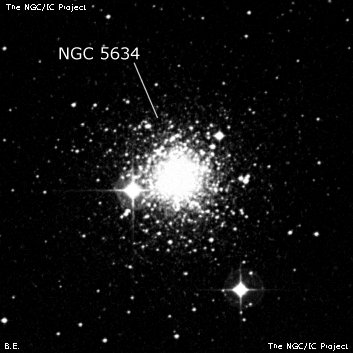
This globular is possibly a former member of the Sagittarius Dwarf Spheroidal Galaxy and appears to be situated in the trailing tidal stream.
William Herschel discovered NGC 5634 = H I-70 = h1813 on 5 Mar 1785 (sweep 380) and recorded "vB, cL, brighter about the middle and the brightness diminishing very gradually, irreg, situated between 3 or 4 considerable stars." There is nothing at his position, but 74 sec of RA west is this globular cluster. John Herschel logged it as "A fine small compressed globular cluster. I can barely discern the stars; the are 19m, 80" diam; has a * 7-8m 90" dist, pos 30° sf, and another 10m np." The latter star is south-preceding."
200/250mm - 8" moderately bright, moderately large. A mag 10 star is on the east edge and a mag 12 star on the west edge.
400/500mm - 17.5" (4/13/96): fairly bright, moderately large, irregularly round, 3.5' diameter. Contains a large bright core of 2' diameter that appears mottled with stellarings or knots. The brightest knot is on the northwest side of the core. Set in a striking field between mag 8.5 SAO 139967 1.4' ESE of the globular and a mag 11 star 1.9' W, with a mag 10 star 3.7' SW of center.
17.5" (6/8/91): bright, round, 3.5' diameter. Situated in a pretty field among three bright stars. The small halo smoothly increases to a broadly concentrated core which is very mottled but not resolved. A few very faint stars are resolved off the edges of the halo at 412x and a star or knot is visible at the west edge of the core.
900/1200mm - 48" (5/10/18): Beautiful globular cluster with 50 stars or more resolved at 375x! Several streams or chains of stars (many easily visible) extend out of the central region, which is densely packed with faint stars over a bright, mottled background glow. A few dozen very dim stars were constantly sparkling in and out of visibility so it wasn't possible to make a decent star count. A very bright orange field star (mag 7.9 HD 127119) is superimposed in the halo on the eastern side [1.4' ESE of center]. Three additional brighter stars in the halo on the west and north side [incl. mag 11.9 star 1.7' NW of center] form a semicircle or crown, partially encircling the halo." The cluster was ~4' diameter, though the outer halo was scraggly without a distinct edge.
Notes by Steve Gottlieb
NGC 4535
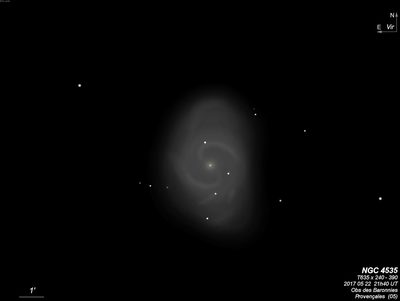
William Herschel discovered NGC 4535 = H II-500 on 28 Dec 1785 (sweep 498) and described "very large, easily resolvable. I see a few of the largest stars in it." In his 1814 PT paper, WH hypothesized this object may be a cluster of stars mixed with nebulosity or a cluster seen at great distance which contains no nebulosity. JH did not make any observations, though d'Arrest made four observations and described it as up to 5 or 6' in size. He also noted the mag 15 star (called mag 17) just 48" preceding the nucleus.
The nickname "Lost Galaxy" is from Leland S. Copeland's February 1955 S&T article "Adventuring in the Virgo Cloud". In his article, Copeland described a star hop through the Virgo Cluster using his 8" Cave reflector. He states, "North of the Diamond is a very dim spiral, here called the Lost Galaxy, NGC 4535." Leland was probably referring to NGC4535's difficulty to locate due to its low surface brightness. The a caption of a photograph states that NGC 4535's "delicate structure shows only on long exposure photographs".
400/500mm - 17.5" (4/18/87): bright, fairly large, very small bright core, elongated SSW-NNE, about 5.5'x4.0'. Appears slightly darker on both sides of core (this is a gap between the spiral arms). A mag 13.5 star is superimposed on the north side 1.0' from the center and a similar star is at the south end of the halo 2.2' from center. A faint mag 14.5 star is just 48" SW of the core. NGC 4526 lies 30' SSW.
600/800mm - 24" (5/24/20): at 260x; bright, large, face-on spiral with a low contrast "S" shape, ~5'x4' N-S. Strongly concentrated with a small bright core elongated N-S and an intense quasi-stellar nucleus. A mag 14.5 star is superimposed 0.8' SW of center. The northern arm was very subtle; it curved clockwise to the west, passing close to a mag 13.5 star 1' N of center. A faint 15" knot, [HK83] #157, was at the end of this arm, 1' NW of center. A low contrast arm on the south side curled towards the east and north. A mag 15 star is 1.2' S of center (just south of the arm) and a mag 14 star is 2.2' S of center at the edge of the outer halo.
900/1200mm - 48" (4/4/13): NGC 4535 is a gorgeous face-on Sc spiral with two, long, very prominent arms extending from a small, very bright central region. The small, very bright core is elongated SSW-NNE and punctuated by an intense, stellar nucleus. The two main arms are clearly attached right at opposite ends of the core. At the northeast end, a beautiful thin arm winds clockwise to the west with a mag 13.5 star pinned on the outer north edge. The arm contains NGC 4535:[HK83] #157 (several additional entries including #141/145 are in Hodge & Kennicutt's "Atlas of HII regions in 125 galaxies"), a small, bright, 15" knot and then dims as it wraps to the south. A mag 14.5 star is situated midway between the nucleus and southern end of this arm [47" SW of the nucleus].
The second main arm is attached at the southwest end of the core and curves clockwise to the southeast, where the arm brightens in an elongated 30" patch (#51/52/72/78), which is symmetrically positioned opposite #157. A fainter arm segment, extending WNW to ESE is visible on the south side, containing #84/90, a small, fairly faint 12" patch, located 1.5' SSE of center. This knot forms the vertex of a flat isosceles triangle with a mag 15 star 0.5' NW and a mag 14 star 0.7' S. The arms are etched on the slightly fainter and larger background glow of the disc, which extends 5.5'x4.0' in a N-S orientation.
Notes by Steve Gottlieb
NGC 5247
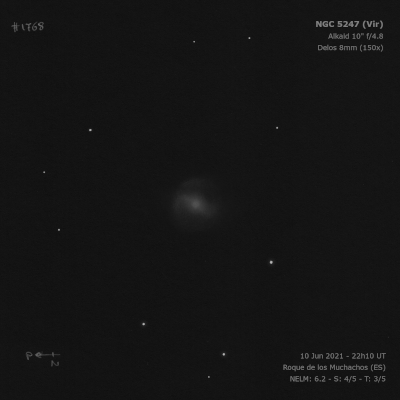
William Herschel discovered NGC 5247 = H II-297 = h1649 on 7 Feb 1785 (sweep 369) and logged "pF, L, mbM." A later observation on 7 Feb 1787 (sweep 732) reads "pB, vL, the greatest part of it vF, unequally bright almost like two joined, the smaller being north preceding [perhaps a spiral arm?]." On sweep 354, John Herschel recorded "vF; vL; psb to a brighter kind of nebula; a good type of its class. It loses itself quite imperceptibly. Diam of the faint neb = 2'; of the brighter part or nucl = 10 or 15". (See fig 39.)".
William Lassell observed this galaxy with his 48-inch from Malta on 20 May 1862 and called it "a very faint spiral Nebula". His sketch (Plate VII, Fig. 29, in Memoirs of the Royal Astronomical Society, Vol 36) shows a graceful S-shaped spiral with two long arms opening widely from a small nucleus. The NGC description "2 branched spiral" refers to Lassell's sketch. Joseph Turner observed it on 8 May 1878 with the 48-inch Great Melbourne Telescope with a 6-day moon in the sky and noted mottling, but no spiral structure.
400/500mm - 17.5" (5/30/92): moderately bright, large, slightly elongated 4:3 SW-NE, about 4'x3', sharp concentration with a very weakly concentrated halo which fades into the background. Unusual appearance as suddenly rises to very small bright core 20"-30" diameter. Spiral structure not seen.
900/1200mm - 48" (5/14/12): I was amazed at the beauty of this face-on spiral with two well-defined spiral arms containing numerous HII knots and a third faint arm! The galaxy is sharply concentrated with an extremely bright round core, ~30" diameter. The slightly brighter and longer southern arm was attached at the north end of the core and winded gracefully counterclockwise for nearly 270°, terminating on the WSW side of the galaxy, 2.4' from center. The arm displayed a high-contrast and was relatively narrow and sharply defined. It contained two knots and brighter segments. It broadened slightly as it unwound on the south side and appeared slightly mottled. The brightest HII knot was 10" in diameter and situated slightly further out, 1.9' SW of center. Beyond this point, the last portion of the arm dimmed and ended at another 8" knot at the tip, 2.4' WSW of center. The northern arm is attached on the south side of the core and winds counterclockwise to the north, though only curves gently. A fairly bright knot (possibly double) is situated along this arm 1.4' NNW of center. Another fainter knot is at the north tip of the arm, 1.8' from center. A third, vaguely defined arm emerges to the south of the core and unwinds counterclockwise to the west. A mag 16.5 star marks the tip of this arm.
Notes by Steve Gottlieb
NGC 5084
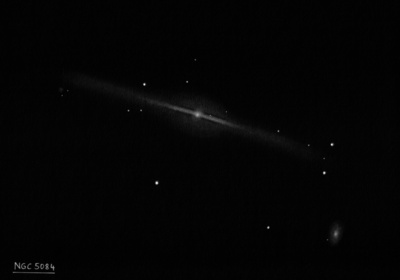
William Herschel discovered NGC 5084 = H II-313 = h1579 on 10 Mar 1785 (sweep 709) and recorded "pB, lE in the parallel, the greatest brightness is towards the following side, which is also the thickest; the preceding part being more like a ray proceeding from it." JH made a single observation, logging "B; R: psbM; 35"."
300/350mm - 13.1" (7/5/83): fairly bright, very elongated 4:1 E-W, fairly large, small bright nucleus with thin faint extensions. Brightest in a group (LGG 345) that includes NGC 5087 and NGC 5134.
Notes by Steve Gottlieb
NGC 5364
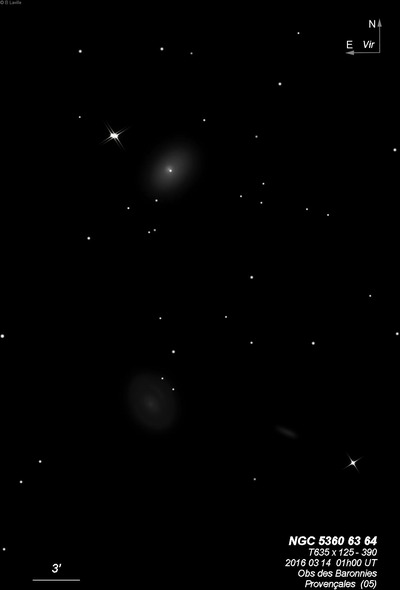
William Herschel discovered NGC 5364 = H II-534 = h1705 on 2 Feb 1786 (sweep 521) and recorded "pB, vL, gbM."
Bindon Stoney found it again on 14 Apr 1852 at Birr Castle and assumed it to be new, so John Herschel catalogued it also as GC 3703. Dreyer combined the two GC entries in the NGC. Harold Corwin suggests that JH's observation of h1678 (later NGC 5317), which he assumed to be new, may be a duplicate observation with a 5 minute error in RA.
200/250mm - 8" (5/21/82): faint, large, diffuse glow. Forms an unusual pair with smaller but brighter NGC 5363 14' N.
400/500mm - 17.5" (4/28/90): moderately bright, large, broad weak concentration, elongated SW-NE. Two mag 14 stars are 1.6' NW of center. Forms a pair with NGC 5360 8' WSW and NGC 5363 lies 14.5' N. Sixth of seven in the NGC 5363 group.
900/1200mm - 48" (3/1/19): at 488x; very bright, very large, oval 3:2 SW-NE, ~4.5'x3.0'. Strongly concentrated with a bright 1.5'x1.0' oval core that increased to a small bright nucleus with direct vision. There was a strong suggestion of spiral structure (arcs) in the large halo, but the contrast was too low to trace the arms. Two mag 14.2/14.4 stars are at the edge of the halo on the NW side and form the base of a thin isosceles triangle with the nucleus. Although the core region was well defined, it didn't appear as a ring.
Notes by Steve Gottlieb
NGC 4754
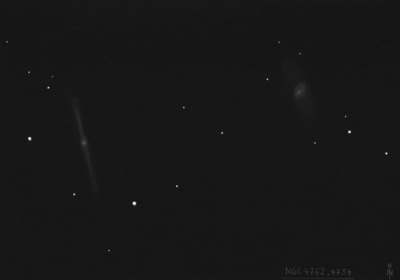
William Herschel discovered NGC 4754 = H I-25 = H II-74 = h1462 on 15 Mar 1784 (sweep 174) and noted "B, S, in a line with two stars. Caroline's reduced position is 18 seconds of RA preceding UGC 8010 and the description nails the identification. The next objects logged are NGC 4754 (again) and NGC 4762 as "Two pB nebula; the preceding [NGC 4754] of them is almost R. The following NGC 4762] vmE; they are not far from the same parallel and about 8 or 10' distant." Hence the two H-designations.
John Herschel made four observations (noting the equivalence of I-25 and II-74) and six observations were made at Birr Castle.
400/500mm - 17.5" (4/13/91): bright, fairly small, slightly elongated halo SSW-NNE, 3' diameter. Sharply concentrated with a very bright small round core containing a substellar nucleus. Located in the center of a group of six faint mag 14 stars. A brighter mag 11 star lies 3.1' SW of center. Forms a pretty pair with NGC 4762 11' SE.
Notes by Steve Gottlieb
NGC 5566
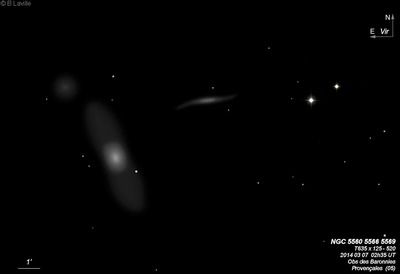
William Herschel discovered NGC 5566 = H I-144 = h1779, along with NGC 5560, on 30 Apr 1786 (sweep 558) and noted "cB, cL, R, gmbM." JH made 3 observations and recorded (sweep 426) "B; R; 40"; gbM; r; has a *12m 1 diam of neb dist nf."
400/500mm - 17.5" (3/23/85): bright, fairly small, slightly elongated SSW-NNE, small bright nucleus. Brightest of three with NGC 5560 5.3' NW and NGC 5569 4.1' NE. A mag 12 star is 1.6' E of center. A pair of mag 8 and 9 stars (SAO 120402 and 120403) lie 10' NW. NGC 5576 (brightest in a trio) lies 40' SSE.
600/800mm - 24" (5/11/13): very bright, very large, very elongated 3:1 SW-NE. Very sharply concentrated with a large, bright elongated core that is also sharply concentrated with an intense elongated nucleus, angled with respect to the major axis. The halo is very diffuse without a sharp edge, but extends at least 4.0'x1.3'. The core is bracketed by mag 12 and 14 stars to the east and west, respectively. NGC 5569 lies 4.3' NE, beyond the edge of the galaxy, and NGC 5560 is 5.3' NW.
900/1200mm - 48" (5/4/16): at 375x; extremely bright and large, very elongated 4:1 SW-NE, 6.0'x1.5'. Very sharply concentrated with a large, roundish, very bright core containing a large, very intense nucleus! The southern extension or arms is slightly wider than the northern counterpart and more evenly lit, though it is brighter along its southern edge, particularly closer to the core region (this is the edge of a spiral arm). The northern branch is brighter along its northern edge and appears to be a low contrast spiral arm, bending or twisting slightly counterclockwise (towards the east). A mag 12 star is 1.6' E of center and a mag 13.8 star is 1.2' WSW. Brightest in an excellent trio with NGC 5560 5.3' NW and NGC 5569 4.3' NE.
Notes by Steve Gottlieb
NGC 4435
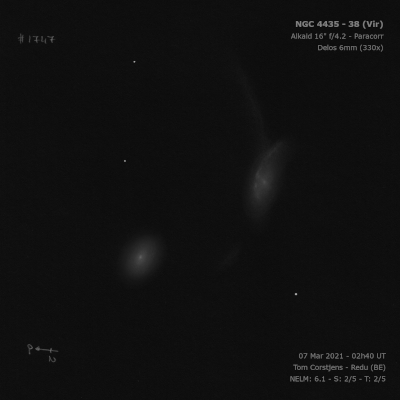
William Herschel discovered NGC 4435 = H I-28.1 = h1274, along with NGC 4438, on 17 Apr 1784 (sweep 199) and recorded "two bright, considerably large nebula. One is 86 of the Connois des Temps." His single position matches the pair NGC 4435/4438 and was confused about the position of M86. He made the same mistake on 8 Apr 1784, though it that case his positions fall close to NGC 4458/4461 (if he viewed NGC 4435/4438 instead, his position was 17' off). John Herschel repeated this error in the Slough catalogue, but in the GC JH split the pair into h1274 = H 1-28.1 (NGC 4435) and h1275 = H 1-28.2 NGC 4438).
NGC 4435 and 4438 was nicknamed "The Eyes" by Leyland S. Copeland (first author of the Deep Sky Wonders column) in a February 1955 article titled "Adventures in the Virgo Cloud."; the likeness to a pair of eyes is emphasized by the fact that NGC 4435 and 4438 are both elongated in a SSW-NNE direction.
300/350mm - 13.1" (5/14/83): bright, prominent small bright core.
400/500mm - 17.5" (4/25/87): bright, fairly small, oval SSW-NNE, bright core, stellar nucleus. Forms a striking pair called the "Eyes" with slightly fainter NGC 4438 4.5' SSE. Located 20' E of M86 in the central core of the Virgo cluster.
600/800mm - 24" (4/28/14): very bright, moderately large, oval 3:2 N-S, ~1.5'x1.0', sharply concentrated with an intensely bright core that increases to the center. Forms a prominent pair ("The Eyes") with NGC 4438 4.4' SSE.
Notes by Steve Gottlieb
NGC 4643
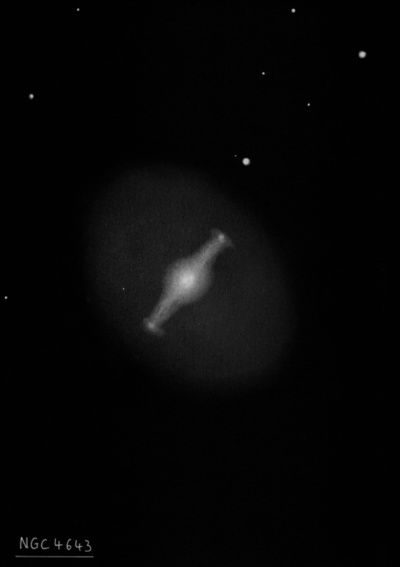
William Herschel discovered NGC 4643 = H I-10 = h1404 on 24 Jan 1784 (sweep 121) and noted "pB, S." His summary description from 4 observations is "vB, pL, lE, gmbM, 2' l, 1 1/2' br." JH called it "B; S; lE; psbM." and measured an accurate position.
400/500mm - 17.5" (3/24/90): fairly bright, moderately large, oval NW-SE, prominent core. Three mag 11-14 stars lie northwest, the closest is a mag 11.5 star 2.4' NW of center.
Notes by Steve Gottlieb
NGC 4593
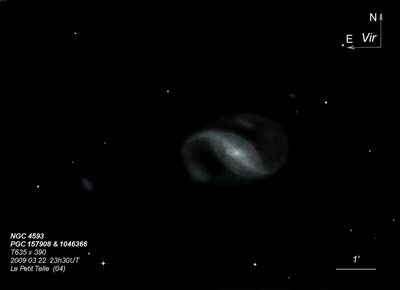
William Herschel discovered NGC 4593 = H II-183 = h1375 on 24 Apr 1784 (sweep 205) and recorded "pB, cL, E, mbM but the brightness confined to a small place." JH made two observations and first logged (sweep 147) "vsbM, to a * 11-12m, with a faint chevelure."
400/500mm - 17.5" (2/28/87): fairly bright, moderately large, elongated WSW-ENE, very bright core, stellar nucleus. First of four within a 32' field including NGC 4602 19' NE. Contains a Sy 1 nucleus and also a Markarian object.
17.5" (1/31/87): moderately bright and large, strong bright core, elongated WSW-ENE.
Notes by Steve Gottlieb
NGC 4902
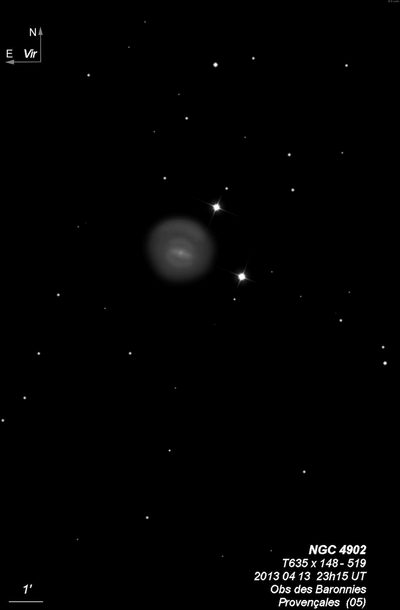
William Herschel discovered NGC 4902 = H I-69 = h1511 on 8 Feb 1785 (sweep 372) and noted "cB, pL, iR." CH's reduction is 10 sec of RA west of MCG -02-33-092 = PGC 44847. Harold Knox-Shaw first identified this galaxy as an "open spiral" in 1915, based on a photograph taken with the 30" reflector at the Helwan Observatory between 1912-14.
200/250mm - 8" (5/21/82): fairly faint, moderately large, round, diffuse.
400/500mm - 17.5" (5/17/90): moderately bright and large, round, weak even concentration to a bright core. Forms the eastern vertex of an equilateral triangle with two mag 10 stars 2.0' NW and 2.2' WSW of center. NGC 4887 is at the edge of the 220x field 10.4' SSW.
Notes by Steve Gottlieb
NGC 5054
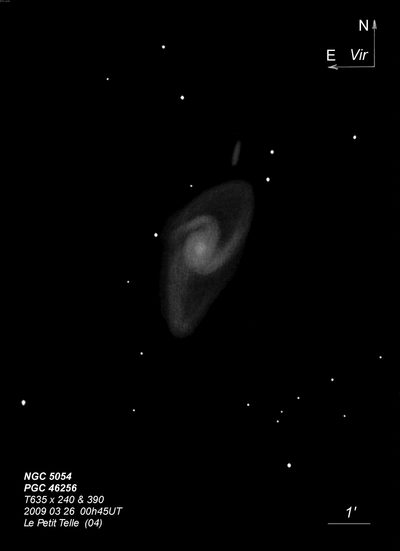
William Herschel discovered NGC 5054 = H II-513 = h1568 on 31 Dec 1785 (sweep 503) and logged "cF, iR." A second observation on 7 May 1787 (sweep 732) reads "pB, almost cB, pL, iF, but mbM." JH noted "vF; R; 20"."
200/250mm - 8" (5/26/84): fairly faint, contains a brighter middle with a diffuse outer halo of low surface brightness; the edge of the halo is difficult to define. One or two faint stars are involved. NGC 5017, NGC 5037 and NGC 5044 all lie to the west.
600/800mm - 24" (6/1/13): bright, large, elongated nearly 2:1 NNW-SSE, ~3.5'x2'. Contains a large, bright core with a sharp, bright nearly stellar nucleus. The overall outline and surface brightness is irregular with spiral structure evident. A relatively thin, straight arm is attached on the west side of the core and shoots ~1.2' NNW, separating well from the central region. A second, lower contrast arm is attached at the NE side of the central region and hugs tightly along the eastern side of the core. This arm was not resolved until it extended south of the central region. A small, brighter knot (~10") is visible just north of the central region [~40" N of center]. A mag 13.5 star is just off the NE side, 1.3' from center, and a mag 14 star lies NW of the western arm, 2.2' from center. Forms a pair with MCG -03-34-040 2.6' NNW. The companion appeared faint, small, very elongated 7:2 N-S (major axis aligned with the nucleus of NGC 5054), 22"x6", even surface brightness. The NGC 5044 group (7 NGCs) lies 20'-30' NW.
900/1200mm - 48" (4/21/17): at 488x and 697x: very bright, large, very irregular 3-armed spiral. Strongly concentrated with an intensely bright core and quasi-stellar nucleus. A thin strong arm is attached to the core on the west side. It shoots nearly straight north, aiming east of a mag 14 star 2.3' NW of center and quickly dimming as it heads towards MCG -03-34-040, a companion 2.6' NNW of center. A second arm begins on the north side of the core. It curls east towards a mag 13.5 star, 1.3' NE of center, and separates from the core. It then dims to a very low surface brightness and curves south, ending ~2' SE of center. A third arm starts on the east side of the core and extends south, ending at a brighter patch or HII region [1.2' SSE of center]. NGC 5044, the brightest of a fairly rich group, lies 27' NW.
MCG -03-34-040 appeared fairly faint, moderately large, thin edge-on 6:1 NNW-SSE, 0.6'x0.1', fairly low even surface brightness. The major axis of the axis "points" towards the core of NGC 5054. The northwestern spiral arm of NGC 5054 heads towards this galaxy, but fades out before reaching it
Notes by Steve Gottlieb
NGC 5701
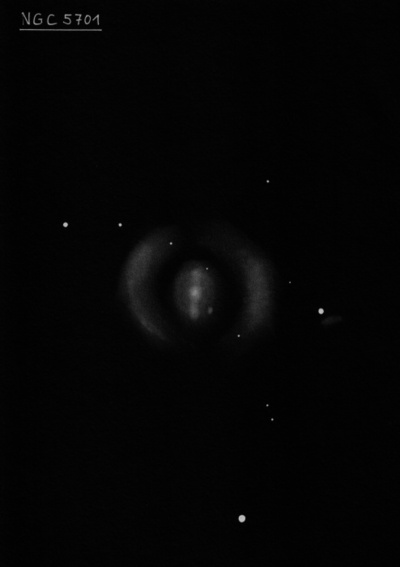
William Herschel discovered NGC 5701 = H II-575 = h1854 on 29 Apr 1786 (sweep 557) and recorded "pB, mbM, cL, iR." JH made a total of 4 observations, first describing the galaxy as "B; R; psbM; 30"."
200/250mm - 8" (6/29/84): moderately bright, small, slightly elongated ~N-S, brighter core, within a triangle of three stars mag 9-10.
400/500mm - 17.5" (6/8/91): bright, moderately large, 2.2'x1.8', faint halo slightly elongated 5:4 NNW-SSE, small well-defined very bright core, stellar nucleus. A mag 14 star is just off the NE side 1.2' from center. Located within a triangle of mag 10 stars 3.6' W, 3.6' NE and 6.3' S of center.
Notes by Steve Gottlieb
NGC 4123
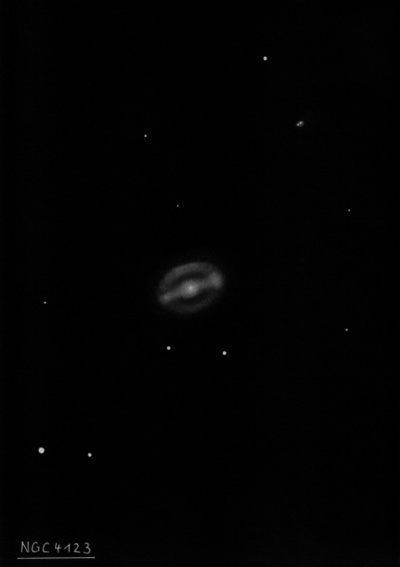
William Herschel discovered NGC 4123 = H V-4 = h1092 on 23 Feb 1784 (sweep 158) and recorded "vF, of a considerable extent, being about 5 or 6' diameter. To the north of the nebula at a distance of about 15' or more is a bright triangle of stars, the base where of is towards the nebula." His position and description matches UGC 7116 = PGC 38531.
R.J. Mitchell, observing on 29 Mar 1856 at Birr Castle, noted "the n one [NGC 4123] is however a spiral like an "S", the arms being faint."
400/500mm - 17.5" (3/28/87): fairly bright, fairly large, elongated 3:2 NW-SE, 3'x2', small bright core. NGC 4116 lies 14.1' SW.
Notes by Steve Gottlieb
NGC 4178
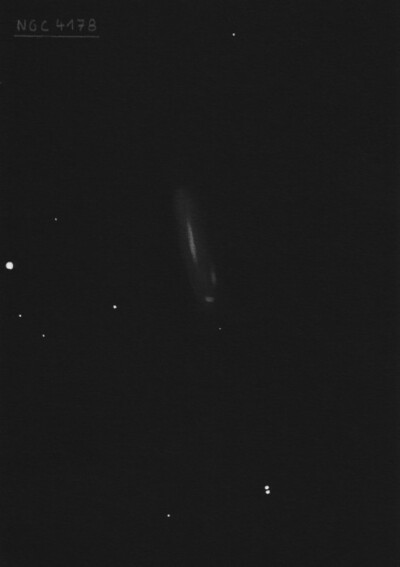
400/500mm - 17.5" (5/14/88): fairly bright, large, very elongated 3:1 SSW-NNE. Gradually increases to a small bright core and faint stellar nucleus.
17.5" (5/10/86): very large but diffuse, very elongated 3:1 SW-NE, very little central concentration but a brighter knot appears along the SW edge. Located 7.0' WNW of mag 7.6 SAO 99995.
Notes by Steve Gottlieb
NGC 4496
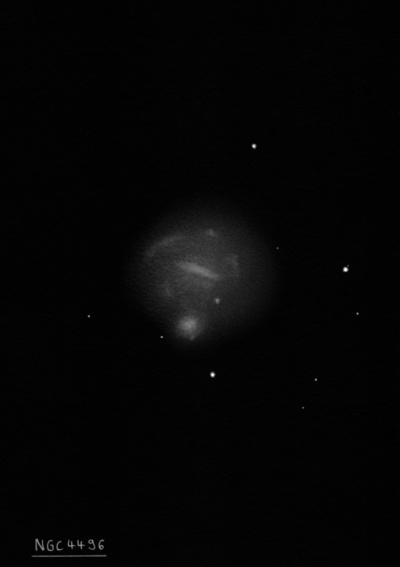
William Herschel discovered NGC 4496 = H II-36 = h1309 on 23 Feb 1784 (sweep 158) and recorded "a faintish pL nebula. It seems to be resolveable." John Herschel made three observations and resolved this double system on the 7 Apr 1828: "A double nebula; vF; pL; both R; pos 45° sf by diag; the two are in contact; unequal." The three editions of the Reference Catalouge of Bright Galaxies label the two components as NGC 4496A and 4496B.
R.J. Mitchell sketched and described this system on 18 Apr 1855 at Birr Castle, "A double neb, alpha [NGC 4496B] is vF, and its light flickering, the other [NGC 4496A] has F neby extending a good way downwards [north], and is much the larger and brighter of the two." Neither JH in the GC or Dreyer in the NGC assigned two designations for the components, although the NGC description reads "bi-nuclear or double nebula".
400/500mm - 17.5" (2/28/87): NGC 4496A is moderately bright, large, elongated WSW-ENE, low even surface brightness. Forms a double system with NGC 4496B = PGC 41473 superimposed at the SSE end. The companion is fairly faint, very small, round, diffuse.
Notes by Steve Gottlieb
NGC 5077
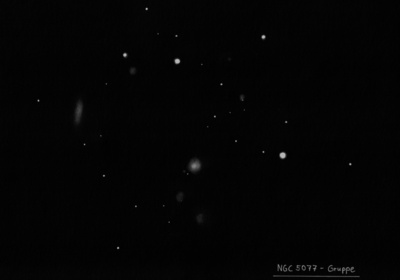
William Herschel discovered NGC 5077 = H II-193 = h1577 = h3490, along with NGC 5076 and NGC 5079, on 11 May 1784 (sweep 211). See his description under NGC 5076. From Slough, JH recorded "B; R; sbM; 30"; the northern and second of 3." d'Arrest made two observations and measured a very accurate position with respect to the mag 7.3 star 33 sec of time preceding.
400/500mm - 17.5" (6/11/88): second of three and brightest in a group with NGC 5079 3.0' SSE and NGC 5076 5.0' S. Fairly bright, fairly small, oval ~N-S, bright core, stellar nucleus. A mag 14 star is 0.9' SE and an extremely faint mag 15 "star" is at the southeast end. The mag 15 "star" mentioned above is actually a very faint companion in contact.
Notes by Steve Gottlieb
NGC 4639
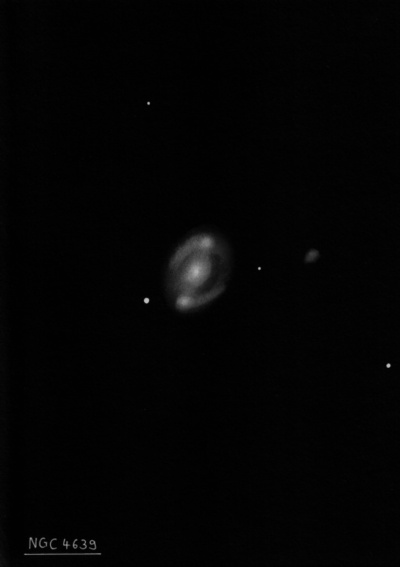
William Herschel discovered NGC 4639 = H II-125 = h1403 on 12 Apr 1784 (sweep 189) and noted "not vF; S; r." His position is 3.7' north of UGC 7884. JH noted "B; E; has a * 12m sf; 1' dist."
R.J. Mitchell, observing with LdR's 72" on 22 Apr 1854, recorded "a remarkable object. Spiral? Suspected a twist to the left at the preceding end." Five nights later he logged "saw tonight the curve in p part previously remarked."
400/500mm - 17.5" (4/13/02): moderately bright and large, elongated 3:2 NW-SE, 1.5'x1.0', broad concentration to a larger, brighter core. The core increases sharply to a small bright nucleus. A mag 12.5 star is close following just 1.0' from center.
17.5" (4/21/90): moderately bright, fairly small, elongated 3:2 NW-SE, 1.6'x1.0', faint stellar nucleus. A mag 12 star is just off the SE side 1.0' from the center. NGC 4654 lies 17' SE and NGC 4659 is 28' NE.
Notes by Steve Gottlieb
NGC 4731
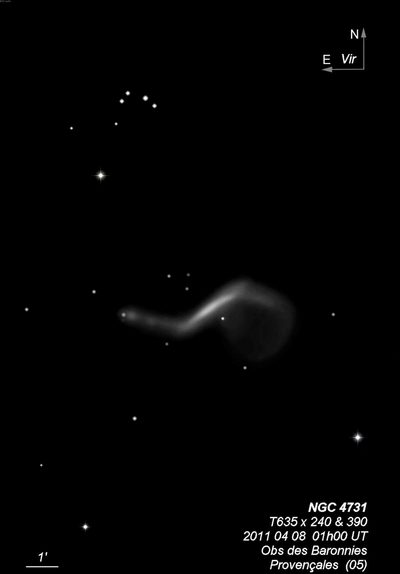
William Herschel discovered NGC 4731 = H I-41 = h1452 on 25 Apr 1784 (sweep 207) and recorded "B, L, lbM, irr figure, resolvable." JH made the single observation "vF; pL; E; third class; sky perfectly clear and fine." His position is accurate although Dreyer was concerned about the discrepant descriptions and positions. In the IC I notes he remarked "H in 1784 described it as "lbM" not "sb M: as in GC. There has apparently not been any change; it is diffused, without concentration. The RA in NGC [from JH] is correct (Armagh, 2 observations)."
400/500mm - 17.5" (5/17/90): faint, fairly small, round, weak concentration, diffuse. A mag 10.5 star is 4' N. Pair with NGC 4731A 10' NNW.
17.5" (5/17/90): fairly faint, large, very elongated 3:1 WNW-ESE, low even surface brightness. A mag 14 star is just south of the nucleus. Forms a pair with NGC 4731A = MCG -01-33-027 10.5' SSE.
900/1200mm - 48" (4/2/11): this is an amazing stretched barred spiral with a long, thin central bar oriented NW-SE and long extensions (spiral arms) at the northwest end gently curving west, along with one at the southeast end of the bar extending east. The entire galaxy forms a very distinctive integral sign outline, stretching 5' E-W! The bar is very bright and very elongated, ~4:1 NW-SE, 1.6'x0.4'. The arm on the east side is slightly brighter and longer. It seems to fan out and become patchy near the end. A 15th magnitude star is at or just beyond the tip. The western arm curves gradually to the south and faint haze extends from the arm to the south increasing the total size. A mag 14 star is just south of the bar and a small triangle of fainter stars is north of the bar. A faint, very small HII knot (NGC 4731:[HK83] 21/22) is squeezed between the triangle of stars and the bar.
NGC 4731A was picked up 10' SSE and appeared moderately bright and large, irregularly round, ~0.6' diameter, broad concentration, brightens gradually to the center. A faint star or knot at the SW edge was not noticed in a quick observation at 375x.
Notes by Steve Gottlieb
NGC 4933
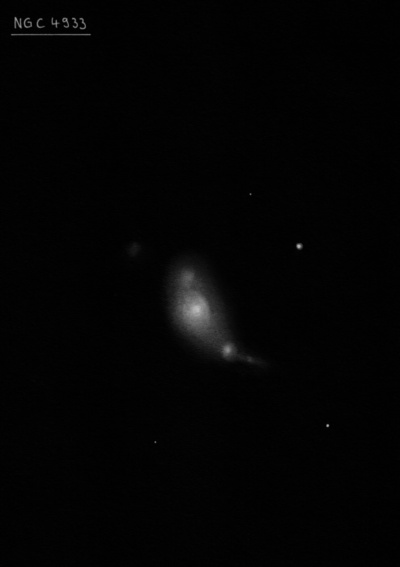
William Herschel discovered NGC 4933 = H II-191 on 9 May 1784 (sweep 210) and recorded "pF, pS, R, r. Near some small stars. Too much daylight to describe it fully." CH's reduced position is ~9 sec of RA west of this double system. In his fifth discovery paper, Wilhelm Tempel remarked that GC 3377 [NGC 4933] was certainly double, with a bright northeast component and a fainter stellar nebula on the southern edge, with a separation of 1'.
On 16 Apr 1895, Bigourdan claimed he searched unsuccessfully for NGC 4933, but reported finding Big. 315 = IC 4173 and Big. 316 = IC 4176, which he noted were in PA 225° (SW-NE) and a separation of 1'. His positions are wrong (over 2 min of RA too far east) as he misidentified his offset star, but once corrected they match the two components (nuclei) of NGC 4933! These IC identifications were resolved in an e-mail correspondence between Malcolm Thomson and Harold Corwin in April 1998. The RC3 labels IC 4173 = NGC 4933A and IC 4176 = NGC 4933B, with the two components first resolved by Tempel. NGC 4933C was not discovered visually.
400/500mm - 17.5" (5/17/90): moderately bright, moderately large, dominated by a bright core, faint extensions 2:1 SW-NE. Forms a contact pair with IC 4173 at the west edge in a common halo (Arp 176). IC 4173 appeared very faint, extremely small, round. Located 7.1' NE of mag 7.5 SAO 157687.
900/1200mm - 48" (4/21/17): NGC 4933 is a double system consisting of compact NGC 4933A = IC 4173 on the southwest side and NGC 4933B = IC 4176 on the northeast end, separated by 45" between centers. At 488x, NGC 4933B appeared bright, moderately large, elongated 4:3 or 3:2 SW-NE, ~1.0'x0.7'. Sharply concentrated with an intensely bright nucleus. The north side has a sharper light cut off [due to dust]. Located 7' NE of mag 7.9 HD 113425.
NGC 4933A on the southwest end appeared bright, fairly small, round, 15" diameter. Strongly concentrated with a very small bright nucleus and thin halo. A tidal tail extension (either from NGC 4933A or 4933B) juts out towards the southwest an additional 20". The combined glow of A and B extends at least 1.5' SW-NE. NGC 4933C = PGC 45143, a third component 1' NE of 4933B, appeared very faint, small, round, ~15" diameter, very low surface brightness.
Notes by Steve Gottlieb
NGC 4260
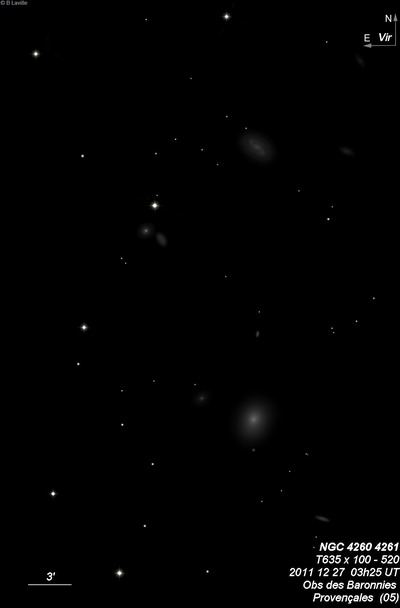
William Herschel discovered NGC 4260 = H II-138 = h1177 on 13 Apr 1784 (sweep 191) and simply noted "F". His position is 3.8' northwest of UGC 6361. JH noted "B; E; psbM." and measured an accurate position (2 sweeps).
400/500mm - 17.5" (3/24/90): fairly bright, moderately large, elongated SW-NE, broadly concentrated halo. A mag 14.5 star is off the NE end 1.4' from center. Located 7' NW of mag 7.7 SAO 11933. NGC 4261 lies 17' S.
600/800mm - 24" (4/28/14): bright or very bright, large, elongated 2:1 SW-NE, 2'x1', sharply concentrated with a very bright round nucleus. A mag 14.7 star is just off the NE edge of the halo. CGCG 042-007 lies 5.4' W ("very faint, very small, round, 15" diameter, low even surface brightness"), IC 3136 is 8' NW ("fairly faint, fairly small, elongated 5:2 SSW-NNE, 30"x12", even surface brightness") and NGC 4269/IC 3155 pair is 8' SE, just south of a mag 7.7 star.
Notes by Steve Gottlieb
NGC 4402
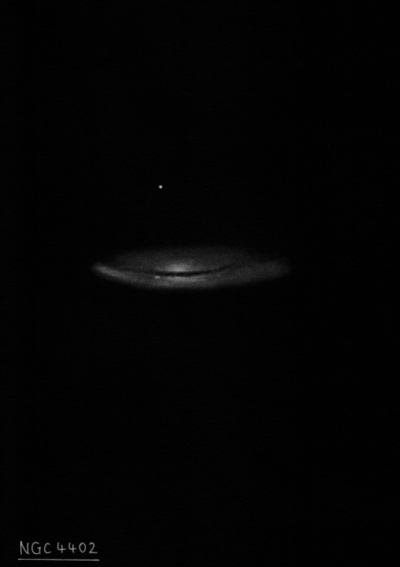
George Johnstone Stoney, Lord Rosse's assistant, discovered NGC 4402 = Au 30 on 13 Apr 1849 and labeled it Eta on the diagram of the central core of the Virgo cluster. He also noted "Eta hollow in the middle [dust lane], probably a ring seen obliquely, faint star north of its middle, seen best with the single lens."
Arthur Auwers independently discovered NGC 4402 on 5 Mar 1862 with the 6.2-inch Fraunhofer heliometer at the Königsberg Observatory and recorded "faint, gradually brighter in the middle, much elongated in the parallel [east-west], 3' long and 1.5' broad." Auwers is credited with the discovery in the GC and NGC as no positions or offsets were measured at Birr Castle.
300/350mm - 13.1" (5/14/83): faint, fairly large, even surface brightness.
400/500mm - 17.5" (4/25/87): fairly faint, fairly large, very elongated 3:1 E-W, fairly even surface brightness. Located 10' N of M86 in core of the Virgo cluster.
600/800mm - 24" (4/28/14): moderately bright, fairly large, very elongated 7:2 E-W, 2.1'x0.6'. Very mottled, patchy appearance implying a dusty equatorial plane and HII regions, though individual knots were not resolved. M86 is 10' N.
Notes by Steve Gottlieb
NGC 5147
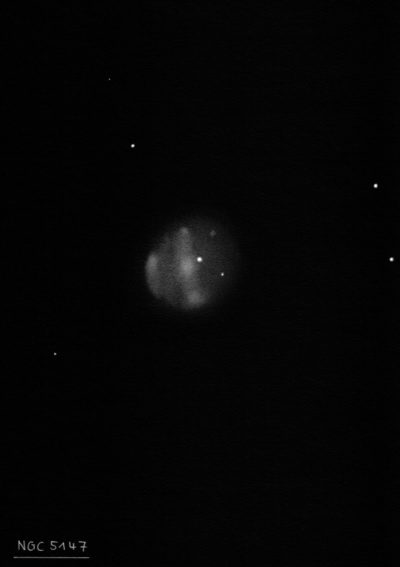
William Herschel discovered NGC 5147 = H II-25 = h1601 on 24 Jan 1784 (sweep 124) and noted "S, obscure; it seems to be resolvable." CH's reduced position is 30 sec of RA east and 2.5' south of UGC 8443. JH called this galaxy "bright" on sweep 142 and three sweeps later he logged it as "faint".
400/500mm - 17.5" (6/3/00): moderately bright and large, round, 2' diameter. Unusual appearance as a mag 13 star is superimposed very close to the geometric center, masquerading as a bright stellar nucleus. The halo is only weakly concentrated but is irregular in surface brightness with a strong hint of structure. A very faint star or knot is on the SW side and the NE edge of the halo has a hint of spiral structure.
Notes by Steve Gottlieb
NGC 4116
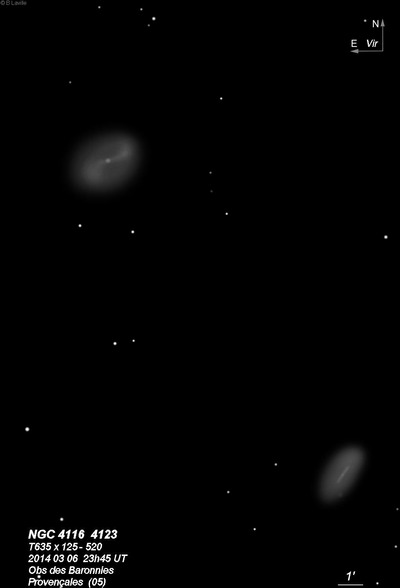
George Johnstone Stoney or his brother Bindon Stoney discovered NGC 4116 on 6 Mar 1851. While observing NGC 4123 it was noted "another also E and vF, about 18' south-preceding." The actual separation is 14', but the identification NGC 4116 = UGC 7111 is certain. On 18 Apr 1855, NGC 4116 was sketched "U" shaped (open at one end) with the comment "a wedge-shaped division running downwards?" Christian Peters measured an accurate position and noted "RA and NPD in the GC [John Herschel's estimated position] not good."
400/500mm - 17.5" (3/28/87): moderately bright, fairly large, elongated NNW-SSE. Appears brighter along the major axis. NGC 4123 lies 14.1' NE.
Notes by Steve Gottlieb
NGC 4795
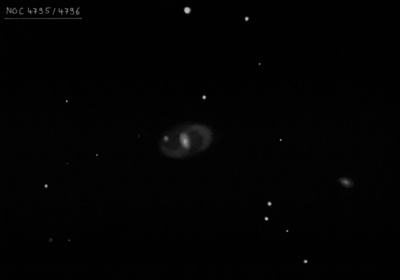
William Herschel discovered NGC 4795 = H II-21 = h1474 on 23 Jan 1784 (sweep 107) and recorded "A nebula, vF and of an irregular shape. 1/2° sp the following star [HD 112503]." JH made three observations, noted "a vS * included, f[ollowing]" and measured an accurate position. The "vS *" applies to NGC 4796!
400/500mm - 17.5" (4/4/92): moderately bright, fairly small, round, slightly elongated NW-SE, bright core, high surface brightness. Forms a contact pair with NGC 4796 attached at the east end, 27" from center. Located 3.9' S of a mag 10 star. NGC 4791 lies 4.7' W and NGC 4803 13' NE.
Notes by Steve Gottlieb
NGC 5257
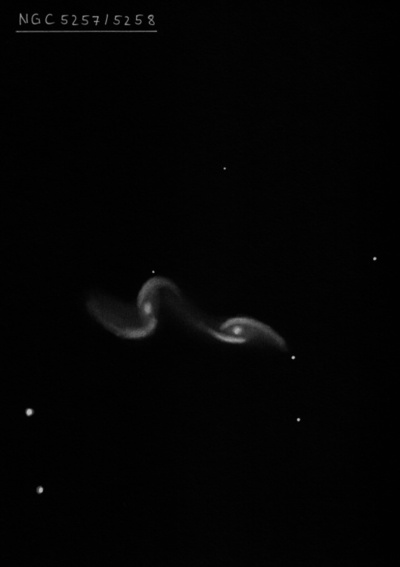
William Herschel discovered NGC 5257 = H II-895 = h1654, along with NGC 5258, on 13 May 1793 (sweep 1044) and noted "F, S, iR." JH made the single observation "The first of 2 comprising a double nebula; both vF; R; bM. The smaller of the two."
400/500mm - 17.5" (4/28/90): fairly faint, fairly small, oval 3:2 WSW-ENE, weak concentration. A mag 14 star is off the west side 1.7' from the center. Forms a close, interacting pair (Arp 240) with NGC 5258 1.3' SE.
900/1200mm - 48" (5/4/16): at 610x; very bright, fairly large, striking two armed-spiral. The central portion only extends ~35", but contains a fascinating structure. Along the southwest and northeast flanks are sharp-edged prominent "arms", appearing as thin, high surface brightness arcs, with the southern arc slightly brighter. Both "arms" are slightly convex, appearing like a close pair of parenthesis enclosing the central region! The northern arm continues as a fainter, but easily visible, fairly thin arc extending west-northwest, and ends just before reaching a mag 15 star [1.7' WNW of center]. A thin, very low surface brightness arm extends west from the southern "parenthesis" towards NGC 5258 (1.4' ESE), but stops just short. The tip-to-tip distance between the two arms is ~1.6'.
On the inside of the two bright "arcs" (blue star-forming arms) there appear to be two thin dust lanes as the surface brightness drops dramatically. At the center is a fairly faint stellar nucleus. The overall appearance is very unusual as the surface brightness of the core region is lower than the thin pair of symmetrical arms.
Notes by Steve Gottlieb
NGC 5679
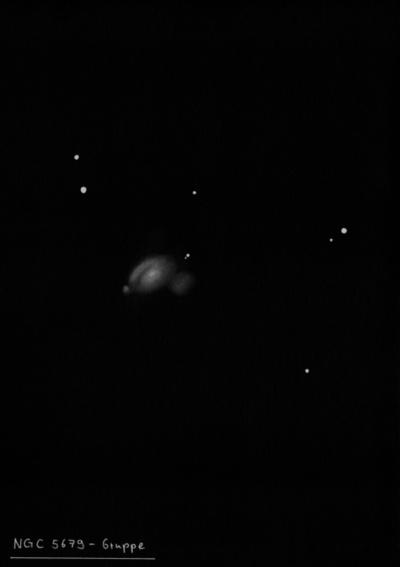
William Herschel discovered NGC 5679 = H II-894 = h1841, along with NGC 5674, on 12 May 1793 (sweep 1043) and noted "F, S." His position is 9 sec of RA west of Arp 274. JH made a total of 5 observations and noted (sweep 250) "among stars and seems attached to a * 12m like a wisp."
400/500mm - 17.5" (6/8/91): faint, small, elongated WNW-ESE, low surface brightness. A mag 12.5 star is attached at the west end 0.7' from center and confuses the view. NGC 5674 is 20' WNW and UGC 9400 18' ESE.
900/1200mm - 48" (5/16/12): MCG +01-37-034, the fainter western component of NGC 5679, appeared fairly faint, fairly small, 30" diameter, round, small bright core. An uncatalogued pair (~6" separation) of relatively bright stars is at the north edge! Forms a close pair with MCG +01-37-035, the brighter eastern component of NGC 5679, just 0.6' following between centers. MCG +01-37-035 appeared fairly bright, moderately large, oval 3:2 or 5:3 WNW-ESE, 0.9'x0.6', well concentrated with a bright core. MCG +01-37-036, the faintest member of the Arp 274 trio, lies 0.6' ESE. It appeared fairly faint, small, oval 4:3 SSW-NNE, weak concentration.
Notes by Steve Gottlieb
IC 1101
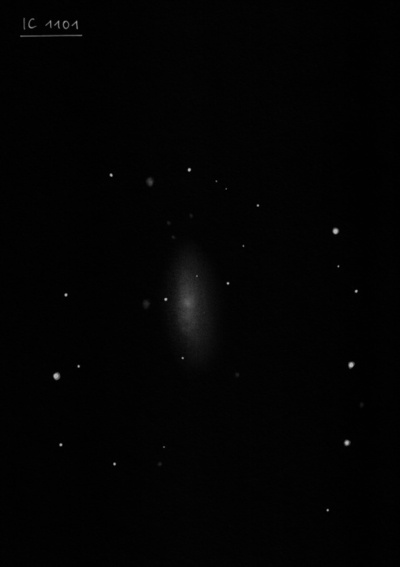
Wikipedia states this galaxy is the largest known in the universe, from 5-6 million light years. A 1991 paper by Uson, Boughn, & Kuhn (ApJ, 369, 46) gives a slightly smaller, though still extremely large diameter of 4 million light years.
Edward Swift, the son of Lewis Swift, discovered IC 1101 = Sw. IX-47 on 19 Jun 1890 at the age of 19. Lewis noted that he and Edward disagreed on the description after the telescope was moved, and as a result no description is given in Swift's 9th discovery list. In his survey of NGC/IC objects around 1900, Herbert Howe found it to be "extremely faint and very small. A star of mag 13 follows 1.5 seconds...and another precedes 2 seconds, a little north." UGC does not label their entry (UGC 9752) as IC 1101.
This is a super-giant cD in the center of AGC 2029 at a distance of 1.07 billion light years (slightly larger redshift than AGC 2065!). IC 1101 is certainly one of the most distant galaxies discovered visually (and possibly the most distant)!
400/500mm - 18" (6/30/11): this supergiant cD galaxy is the central galaxy in AGC 2029 (z = .078 at 1.0 billion light years!). At 280x, it appeared very faint, very small, slightly elongated ~N-S, ~15"x10". Visible continuously with averted vision. The galaxy is centered within a 9-member circlet of 12th- to 14th-magnitude stars and squeezed between a mag 14.7 star 27" E and a mag 15-15.5 star 47" WNW (just slightly south of a line connecting these stars). No other members of the cluster were seen. I also viewed IC 1101 at a similar magnification in a 24" f/3.3 and logged it as "faint, very small, oval 3:2 N-S, ~20"x14". Could just hold steadily with direct vision."
Notes by Steve Gottlieb
IC 972
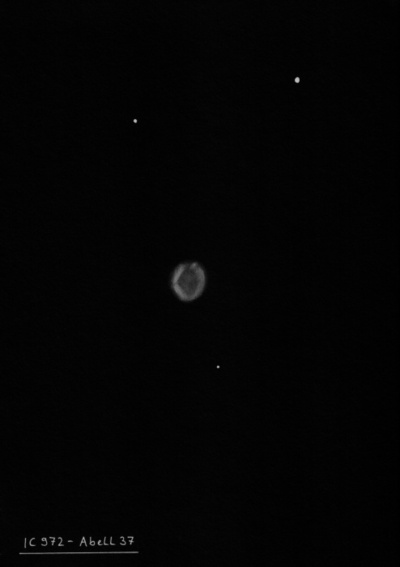
Stephane Javelle discovered IC 972 = J 1-272 on 25 May 1892 with the 30" refractor at the Nice Observatory. Although the IC position is accurate, Abell assumed it was new and included it as #37 in his list of new planetary nebulae found by inspection of the POSS. So, IC 972 = Abell 37.
300/350mm - 13.1" (4/10/86): at 79x and OIII filter appears fairly faint, fairly small, round, with an even surface brightness and sharp edges. Faint but visible without filter. Easily takes 166x with a UHC filter. No central star seen with or without a filter.
400/500mm - 17.5" (5/11/96): faint but easily picked up at 100x without filter as a moderately large, round disc less than 1' diameter. Nicely enhanced with OIII filter and appears moderately bright, crisp-edged and slightly elongated N-S, 45"x40". Also nice view at 100x with UHC filter. Located 6.7' S of mag 9.4 SAO 158326.
Notes by Steve Gottlieb
NGC 5331
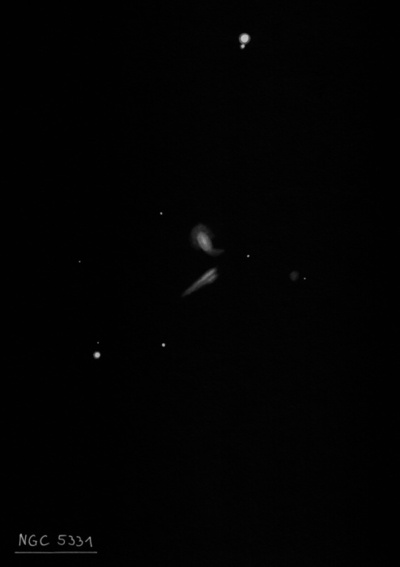
William Herschel discovered NGC 5331 = H III-929 = h1687 on 13 May 1793 (sweep 1044) and logged "vF, S, E in meridian." JH made an interesting observation on sweep 144: "A very insignificant cluster of vS scattered stars; or a S[mall] resolved neb." The position here is on the brighter component of the double system.
400/500mm - 17.5" (5/11/96): this double system was resolved with the brighter component (VV 253b) at the north end. VV 253b is fairly faint, fairly small and slightly elongated. Attached at the south end is a low surface glow (VV 253a). The pair requires attention as there is less than 30" separation between centers. NGC 5329 lies 14' N.
900/1200mm - 48" (5/12/18): at 488x and 610x; NGC 5331 is an interacting pair at 25" separation N-S. The southern component (VV 253a) appeared moderately bright and large, elongated NW-SE but with an irregular outline. Contains a brighter elongated core with a faint stellar nucleus. The galaxy thins on the southeast end with a faint extension or tail, creating an asymmetric appearance. The northern galaxy (VV 253b) appeared fairly bright or bright, moderately large, oval 2:1 SW-NE, irregular outline. Contains a high surface brightness elongated core with a stellar nucleus.
CGCG 017-081, situated 1.3' W of the pair, appeared fairly faint, small, round, 15" diameter, a 17th mag star is 15" WSW. A 16th magnitude star lies midway between the CGCG and the NGC pair.
48" (5/4/16): at 697x; NGC 5531 is a fascinating interacting pair (25" between centers) with a third component (CGCG 017-081) 1.3' W. The northern component (VV 253b = PGC 49266) is fairly bright, moderately large, elongated 2:1 or 5:2 SW-NE, 30"x12", sharply concentrated with a prominent, elongated core and bright stellar nucleus. The surface brightness of the halo is irregular with a hint of spiral structure.
The southern galaxy (highly disrupted on the SDSS with a tidal plume to the WNW) is fairly bright, fairly large, elongated 3:1 NW-SE, broad concentration but no well defined zones. The surface brightness, though, is irregular or mottled and the galaxy appears dusty. More unusual is the shape; the galaxy tapers at the southeast east and the northwest end bends or twists towards the northern spiral, creating a kidney-bean outline.
CGCG 017-081, 1.3' W, appeared fairly faint, small, round, 15" diameter, nearly even surface brightness. A mag 16.5 star is just 14" WSW of center. A mag 16 star sits midway between this galaxy and the NGC 5331 pair.
Notes by Steve Gottlieb
NGC 4697
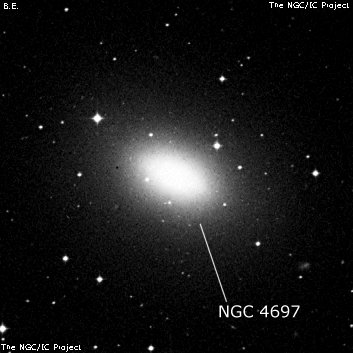
William Herschel discovered NGC 4697 = H I-39 = h1436 on 24 Apr 1784 (sweep 205) and described "vB, vL, iE, mbM but the brightness breaks off abruptly [sharply concentrated] so as almost to resemble a resolvable nucleus consisting of 4 or 5 bright stars. There is however too much moonlight to describe the nebula completely." On 20 Mar 1789 (sweep 913), he also logged "vB, lE from sp to nf, vgbM, 3 or 4' long, but clouds coming on." He published a sketch in his 1811 paper (Fig. 23) as an illlustration of "nebulae that are suddenly much brighter in the middle."
400/500mm - 17.5" (4/21/90): very bright, fairly large, elongated 2:1 WSW-ENE. Even concentration in halo, then a very bright intense core. The large halo gradually fades out at edges. A mag 12 star is 2.7' NE of center. Located 35' NNE of mag 6.3 SAO 138967. Visible in the 16x80 finder. Brightest in a large, loose galaxy group (LGG 314) with two dozen members including NGC 4731, 4941, 4948, 4951 and 4958.
Notes by Steve Gottlieb
NGC 4526
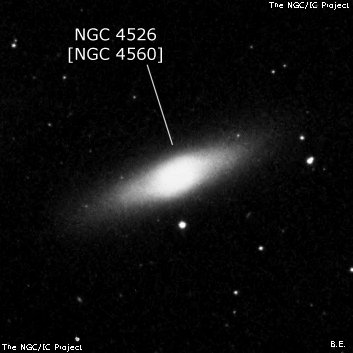
400/500mm - 17.5" (4/18/87): very bright, fairly large, very elongated WNW-ESE, bright core, strong stellar nucleus. A mag 12.5 star is 1.3' S of center. Located midway between mag 6.9 SAO 119466 7.6' W and mag 6.7 SAO 119479 7.2' ENE. Supernova 1994C observed at 12th magnitude on 3/12/94 five days after discovery.
600/800mm - 24" (5/20/17): very bright, very large, very elongated 3:1 WNW-ESE, ~3.75'x1.25'. Contains a large, rounder core with a small intense nucleus that seems slightly offset south of center. The extensions gradually fade out towards the tips. Situated at the midpoint of mag 7.0 HD 109285 7.5' WSW and mag 6.8 HD 109417 7.3' ENE. NGC 4518 lies 15' NW.
Notes by Steve Gottlieb
NGC 4636
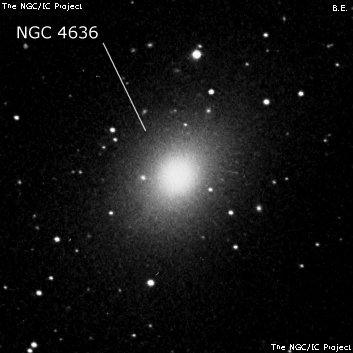
William Herschel discovered NGC 4636 = H II-38 = h1399 = h1401 on 23 Feb 1784 (sweep 158) and recorded "pB, pL. It seems to be of the resolvable kind, and is of an irregular shape." JH measured two good positions under h1399, logging "B; L; R; vgvmbM but not to a nucleus." in sweep 238. But on sweep 142, he listed it again as h1401, a possible "Nova", this time with a 1° error in declination (too far north).
400/500mm - 17.5" (3/24/90): very bright, large, slightly elongated NW-SE, very bright core, substellar nucleus, extensive halo appears mottled. Located between two mag 12/13 stars 3.4' NNW and 3.1' S, respectively.
600/800mm - 24" (2/24/20): at 200x; I took a quick look at this galaxy to observed SN 2020ue, a type Ia supernova discovered on 12 Jan '20. It was very easy to identify as roughly 14th magnitude.
Notes by Steve Gottlieb
NGC 4699
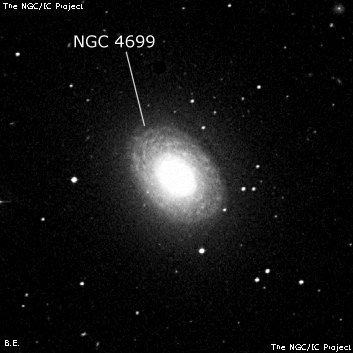
William Herschel discovered NGC 4699 = H I-129 = h1437 = h3425 on 3 Mar 1786 (sweep 536) and recorded "very brilliant, iR, vgmbM." From Slough, John Herschel described "vB; R; vsmbM to a fine resolvable nucleus, 40". He mistakenly added in parentheses "doubtless a globular cluster".
Based on photos taken at the Helwan Observatory in Egypt in 1919-20, the galaxy was described as "A curious and complex form of spiral. The N is vB and alm stellar. From it project two bright slightly curved spiral arms in p.a. 55° and total length 40"; these merge into a pB oval disc with a sharp edge 1' x 40", E 50° in which are dark lanes and indications of spiral structure; outside this is a vF slightly irr. oval disc 3.5'x 2', E 45°. "
400/500mm - 17.5" (4/21/90): very bright, moderately large, elongated 3:2 SSW-NNE, very small intense core with a bright stellar nucleus.
Notes by Steve Gottlieb
NGC 4365
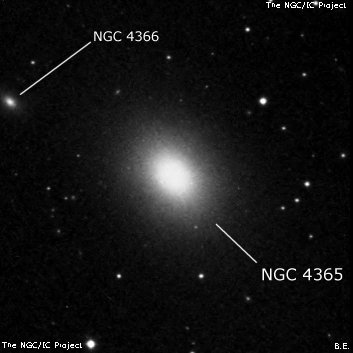
William Herschel discovered NGC 4365 = H I-30 = h1232 on 13 Apr 1784 (sweep 191) and recorded "pB, pL, or an iR form, mbM, r." His position is within 1' east of UGC 7488.
400/500mm - 17.5" (3/28/87): very bright, large, elongated SW-NE, bright core, very small or stellar nucleus. The NGC 4343 group is close SW and NGC 4370 lies 10' NE.
Notes by Steve Gottlieb
NGC 5846
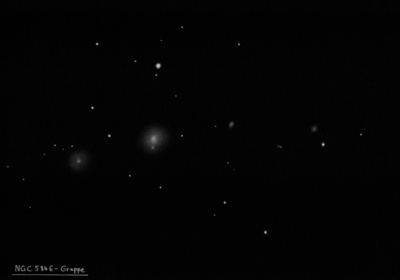
William Herschel discovered NGC 5846 = H I-128 = h1901, along with NGC 5845, on 24 Feb 1786 (sweep 532) and recorded "vB, pL, bM. With one preceding NGC 5845] just [at edge of field]; and 5' more north, and vF, R. I saw also a third small one preceding." The "third small one preceding" might refer to NGC 5839, which has a separate log entry or Wolfgang Steinicke suggests it might apply to NGC 5846A, the very close companion on its south side. On 13 Apr 1838, John Herschel logged "B; R; psbM to nucleus; 30" [diameter]."
John Herschel's first observation of NGC 5846 was on 29 May 1821 while being instructed on sweeping techniques by his elderly father. His Aunt Caroline recorded the observation: "F; R; gmbM; resolvable; appears to have 2 nuclei; south following in the same field is a very small, round nebula." James South also took a look and exclaimed (quoted in JH's journal), "O! Good God! It is worth going to the devil for! The second nuclei is NGC 5846A. This short sweep (4 objects) was later registered out of order as sweep 53. He observed NGC 5846 again the next night (sweep 54) and noted "The neb of last night with the 2 nuclei." Guillaume Bigourdan also resolved the companion and noted Big. II-75 as "round, stellar centre, forms a very close companion to 4045 G.C. [NGC 5846]."
In addition, Edward Burton, observing with LdR's 72" on 25 Apr 1868, logged "h1901 [NGC 5846] is double, 3rd Nucleus suspected on n side." The third nucleus is a faint star. On 3 May 1877 Dreyer also noted "companion nebula [to NGC 5846] vS, less than 1' south." But the following year he commented "small star (NOT a nebula) involved south." This was likely the reason Dreyer did not enter NGC 5846A into the NGC. DeVaucouleurs introduced the NGC 5846A designation in the RC I.
400/500mm - 17.5" (5/10/91): bright, moderately large, oval 3:2 NNW-SSE, 3'x2', evenly concentrated as halo brightens down to a small bright core but no nucleus, fainter halo. Forms a contact pair with NGC 5846A (appears as a mag 13.5 "star") embedded in the southern portion of halo 40" from the center! Brightest in a group with NGC 5850 10' ESE and NGC 5845 8' WNW.
600/800mm - 24" (6/23/17): at 375x; very bright, moderately large, round, 1.5'-2' diameter. Sharply concentrated with an intensely bright nucleus that increases to the center. Large, round halo gradually fades at periphery. NGC 5846A is situated on the south side of the halo and appeared moderately bright, high surface brightness but very small and round, 15" diameter.
24" (6/14/15): bright, fairly large, round, 1.8' diameter, sharply concentrated with a very bright core. The outer halo has a low surface brightness. NGC 5846A is on the south side of the halo [44" from center]. It appeared as a fairly faint compact glow, round, 15" diameter, fairly high surface brightness. A much fainter mag 15.5 star is superimposed 25" N of center. NGC 5850 lies 10' SE.
Notes by Steve Gottlieb
NGC 4716
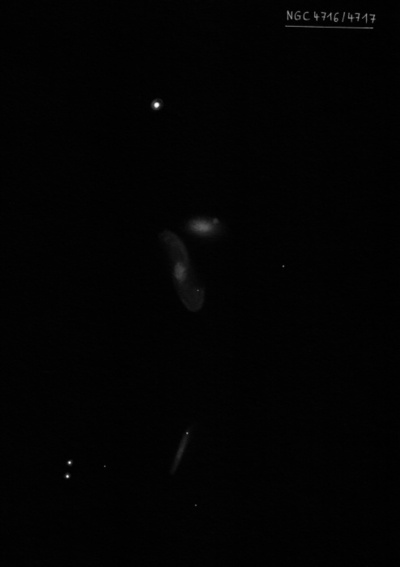
Wilhelm Tempel discovered NGC 4716 = T V-19, along with NGC 4717, on 12 Apr 1882 with the 11-inch Amici I refractor at Arcetri Observatory near Florence. His description in the main table reads "Double nebula; the position is that of the brighter, north preceding [NGC 4716], has a definite stellar nucleus. The small, fainter companion NGC 4717] follows by 1 sec and is barely 3/4' south. A star 11-12m is 2' north." His micrometric position is an exact match with MCG -01-33-021 = PGC 43464.
400/500mm - 18" (4/9/05): fairly faint, small, round, 0.4' diameter. Sharply concentrated with a very small bright nucleus. Forms a double system with NGC 4717 just 0.8' SSE.
Notes by Steve Gottlieb
NGC 5718
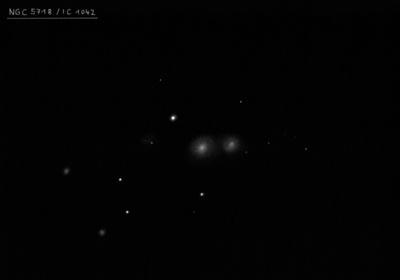
William Herschel discovered NGC 5718 = H III-550 = h1862 on 30 Apr 1786 (sweep 558) and recorded "vF, S, preceding and in a line with 2 B stars." His position is 2' south of this double system and the two stars are collinear with the brighter eastern component UGC 9459. Neither Herschel noticed IC 1042 close west.
400/500mm - 17.5" (6/8/91): faint, fairly small, elongated 4:3 E-W, weak concentration. Located 1.3' SW of a mag 10 star that detracts from viewing. A number of mag 13-14 stars are within 3'. Forms a close contact pair (Arp 171) with IC 1042 off the west edge. IC 1042 is very faint, very small, low even surface brightness.
600/800mm - 24" (6/18/12): moderately bright, fairly small, oval 3:2 or 4:3 E-W, ~35"x25", large bright core, brighter along the major axis. Forms a double system (Arp 171) with IC 1042 ("fairly faint, fairly small, round, 24" diameter, weak concentration"), just 1.0' WNW. A mag 10.7 star is 1.2' NE and detracts a bit. NGC 5718 is the brightest member in the poor group MKW 8 and over 20 members were tracked down within 30' of NGC 5718.
Notes by Steve Gottlieb
NGC 5674
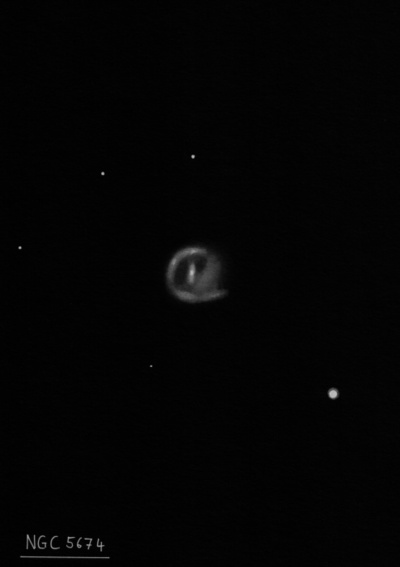
William Herschel discovered NGC 5674 = H II-893 = h1837 on 12 May 1793 (sweep 1043) and noted "pB, S, iF." JH made 4 observations and his mean position is at the north edge of the galaxy.
400/500mm - 17.5" (6/8/91): fairly faint, fairly small, round, broad concentration. NGC 5679 lies 20' ESE.
Notes by Steve Gottlieb
HCG 62
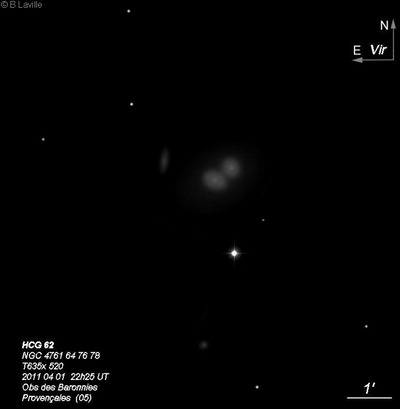
| Type | GALCL [E3] |
| RA | 12:53:08.2 |
| Dec | -09:13:27.0 |
| major_axis | 4.8' |
| mag | 11.6 |
| surface_bright | 99.9 |
HCG 67
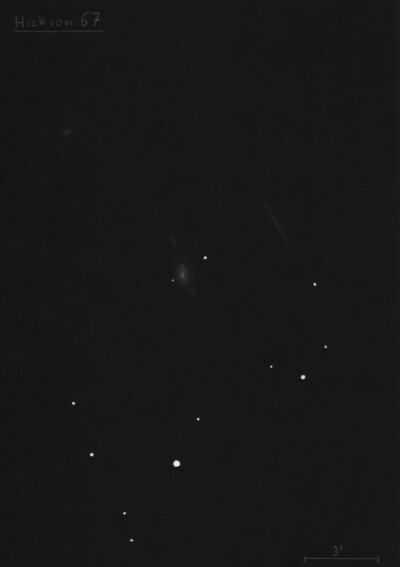
| Type | GALCL [E3] |
| RA | 13:49:03.5 |
| Dec | -07:12:20.0 |
| major_axis | 4.3' |
| mag | 11.6 |
| surface_bright | 99.9 |
IC 3322A
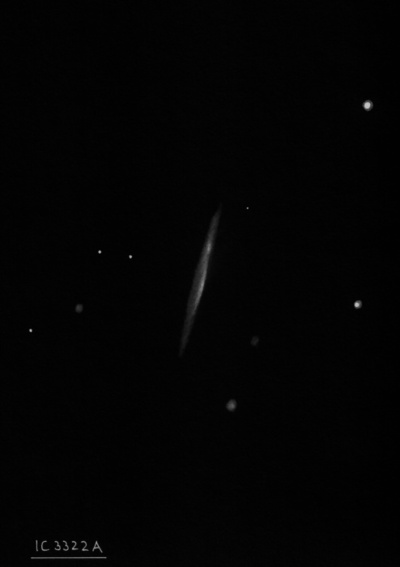
| Type | GX [SBc] |
| RA | 12:25:42.7 |
| Dec | +07:13:01.0 |
| major_axis | 3.4' |
| minor_axis | 24.0'' |
| position_angle | 157.0 |
| mag | 12.9 |
| surface_bright | 13.0 |
Abell 36
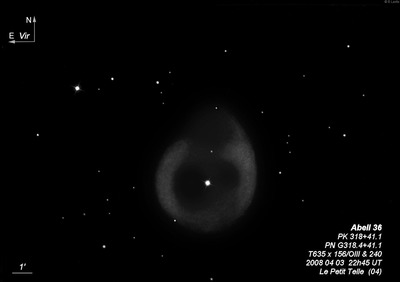
| Type | PN [3b(3a)] |
| RA | 13:40:41.3 |
| Dec | -19:52:55.0 |
| major_axis | 6.0' |
| minor_axis | 5.0' |
| mag | 13.0 |
| surface_bright | 16.4 |
HCG 64

| Type | GALCL [S2] |
| RA | 13:25:43.3 |
| Dec | -03:51:28.0 |
| major_axis | 2.2' |
| mag | 13.4 |
| surface_bright | 99.9 |
PGC 43493
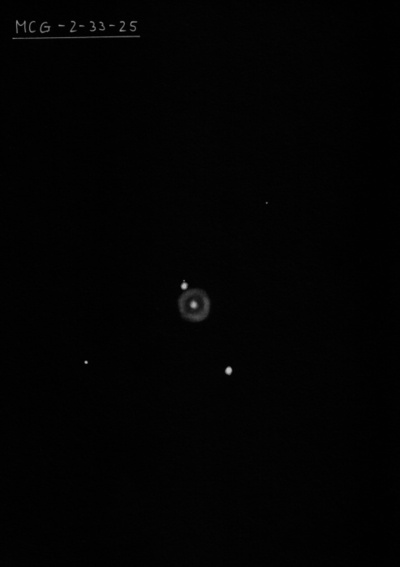
| Type | GX [SO] |
| RA | 12:50:53.3 |
| Dec | -09:51:43.0 |
| major_axis | 84.0'' |
| minor_axis | 72.0'' |
| position_angle | 80.0 |
| mag | 13.7 |
| surface_bright | 14.4 |
UGC 7522
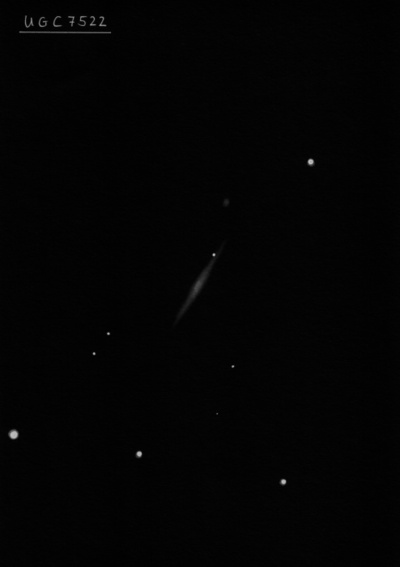
| Type | GX [Sc] |
| RA | 12:25:58.5 |
| Dec | +03:25:47.0 |
| major_axis | 2.6' |
| minor_axis | 18.0'' |
| position_angle | 129.0 |
| mag | 13.7 |
| surface_bright | 13.9 |
IC 3591
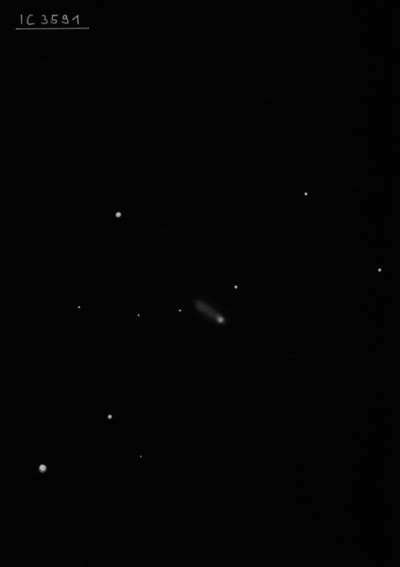
| Type | GX [IBm] |
| descr | HOLM 428B = IC 3589 is a star. |
| RA | 12:37:02.8 |
| Dec | +06:55:34.0 |
| major_axis | 72.0'' |
| minor_axis | 36.0'' |
| position_angle | 48.0 |
| mag | 13.8 |
| surface_bright | 13.2 |
UGC 6970
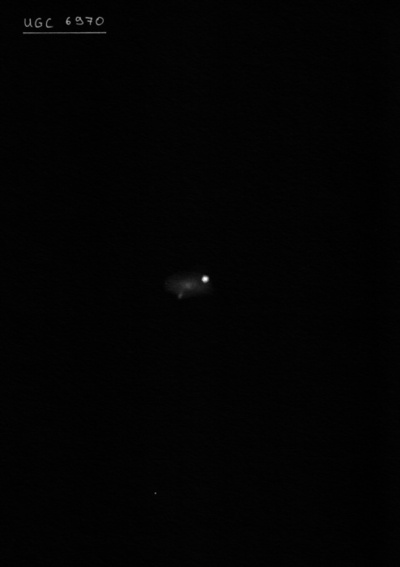
| Type | GX |
| RA | 11:58:45.7 |
| Dec | -01:26:42.0 |
| major_axis | 90.0'' |
| minor_axis | 48.0'' |
| position_angle | 75.0 |
| mag | 14.2 |
